

How to Improve Problem-Solving Skills: Mathematics and Critical Thinking

In today’s rapidly changing world, problem-solving has become a quintessential skill. When we discuss the topic, it’s natural to ask, “What is problem-solving?” and “How can we enhance this skill, particularly in children?” The discipline of mathematics offers a rich platform to explore these questions. Through math, not only do we delve into numbers and equations, but we also explore how to improve problem-solving skills and how to develop critical thinking skills in math. Let’s embark on this enlightening journey together.
What is Problem-Solving?
At its core, problem-solving involves identifying a challenge and finding a solution. But it’s not always as straightforward as it sounds. So, what is problem-solving? True problem-solving requires a combination of creative thinking and logical reasoning. Mathematics, in many ways, embodies this blend. When a student approaches a math problem, they must discern the issue at hand, consider various methods to tackle it, and then systematically execute their chosen strategy.
But what is problem-solving in a broader context? It’s a life skill. Whether we’re deciding the best route to a destination, determining how to save for a big purchase, or even figuring out how to fix a broken appliance, we’re using problem-solving.
How to Develop Critical Thinking Skills in Math
Critical thinking goes hand in hand with problem-solving. But exactly how to develop critical thinking skills in math might not be immediately obvious. Here are a few strategies:
- Contextual Learning: Teaching math within a story or real-life scenario makes it relevant. When students see math as a tool to navigate the world around them, they naturally begin to think critically about solutions.
- Open-ended Questions: Instead of merely seeking the “right” answer, encourage students to explain their thought processes. This nudges them to think deeply about their approach.
- Group Discussions: Collaborative learning can foster different perspectives, prompting students to consider multiple ways to solve a problem.
- Challenging Problems: Occasionally introducing problems that are a bit beyond a student’s current skill level can stimulate critical thinking. They will have to stretch their understanding and think outside the box.
What are the Six Basic Steps of the Problem-Solving Process?
Understanding how to improve problem-solving skills often comes down to familiarizing oneself with the systematic approach to challenges. So, what are the six basic steps of the problem-solving process?
- Identification: Recognize and define the problem.
- Analysis: Understand the problem’s intricacies and nuances.
- Generation of Alternatives: Think of different ways to approach the challenge.
- Decision Making: Choose the most suitable method to address the problem.
- Implementation: Put the chosen solution into action.
- Evaluation: Reflect on the solution’s effectiveness and learn from the outcome.
By embedding these steps into mathematical education, we provide students with a structured framework. When they wonder about how to improve problem-solving skills or how to develop critical thinking skills in math, they can revert to this process, refining their approach with each new challenge.
Making Math Fun and Relevant
At Wonder Math, we believe that the key to developing robust problem-solving skills lies in making math enjoyable and pertinent. When students see math not just as numbers on a page but as a captivating story or a real-world problem to be solved, their engagement skyrockets. And with heightened engagement comes enhanced understanding.
As educators and parents, it’s crucial to continuously ask ourselves: how can we demonstrate to our children what problem-solving is? How can we best teach them how to develop critical thinking skills in math? And how can we instill in them an understanding of the six basic steps of the problem-solving process?
The answer, we believe, lies in active learning, contextual teaching, and a genuine passion for the beauty of mathematics.
The Underlying Beauty of Mathematics
Often, people perceive mathematics as a rigid discipline confined to numbers and formulas. However, this is a limited view. Math, in essence, is a language that describes patterns, relationships, and structures. It’s a medium through which we can communicate complex ideas, describe our universe, and solve intricate problems. Understanding this deeper beauty of math can further emphasize how to develop critical thinking skills in math.
Why Mathematics is the Ideal Playground for Problem-Solving
Math provides endless opportunities for problem-solving. From basic arithmetic puzzles to advanced calculus challenges, every math problem offers a chance to hone our problem-solving skills. But why is mathematics so effective in this regard?
- Structured Challenges: Mathematics presents problems in a structured manner, allowing learners to systematically break them down. This format mimics real-world scenarios where understanding the structure of a challenge can be half the battle.
- Multiple Approaches: Most math problems can be approached in various ways . This teaches learners flexibility in thinking and the ability to view a single issue from multiple angles.
- Immediate Feedback: Unlike many real-world problems where solutions might take time to show results, in math, students often get immediate feedback. They can quickly gauge if their approach works or if they need to rethink their strategy.
Enhancing the Learning Environment
To genuinely harness the power of mathematics in developing problem-solving skills, the learning environment plays a crucial role. A student who is afraid of making mistakes will hesitate to try out different approaches, stunting their critical thinking growth.
However, in a nurturing, supportive environment where mistakes are seen as learning opportunities, students thrive. They become more willing to take risks, try unconventional solutions, and learn from missteps. This mindset, where failure is not feared but embraced as a part of the learning journey, is pivotal for developing robust problem-solving skills.
Incorporating Technology
In our digital age, technology offers innovative ways to explore math. Interactive apps and online platforms can provide dynamic problem-solving scenarios, making the process even more engaging. These tools can simulate real-world challenges, allowing students to apply their math skills in diverse contexts, further answering the question of how to improve problem-solving skills.
More than Numbers
In summary, mathematics is more than just numbers and formulas—it’s a world filled with challenges, patterns, and beauty. By understanding its depth and leveraging its structured nature, we can provide learners with the perfect platform to develop critical thinking and problem-solving skills. The key lies in blending traditional techniques with modern tools, creating a holistic learning environment that fosters growth, curiosity, and a lifelong love for learning.
Join us on this transformative journey at Wonder Math. Let’s make math an adventure, teaching our children not just numbers and equations, but also how to improve problem-solving skills and navigate the world with confidence. Enroll your child today and witness the magic of mathematics unfold before your eyes!
FAQ: Mathematics and Critical Thinking
1. what is problem-solving in the context of mathematics.
Problem-solving in mathematics refers to the process of identifying a mathematical challenge and systematically working through methods and strategies to find a solution.
2. Why is math considered a good avenue for developing problem-solving skills?
Mathematics provides structured challenges and allows for multiple approaches to find solutions. This promotes flexibility in thinking and encourages learners to view problems from various angles.
3. How does contextual learning enhance problem-solving abilities?
By teaching math within a story or real-life scenario, it becomes more relevant for the learner. This helps them see math as a tool to navigate real-world challenges , thereby promoting critical thinking.
4. What are the six basic steps of the problem-solving process in math?
The six steps are: Identification, Analysis, Generation of Alternatives, Decision Making, Implementation, and Evaluation.
5. How can parents support their children in developing mathematical problem-solving skills?
Parents can provide real-life contexts for math problems , encourage open discussions about different methods, and ensure a supportive environment where mistakes are seen as learning opportunities.
6. Are there any tools or apps that can help in enhancing problem-solving skills in math?
Yes, there are various interactive apps and online platforms designed specifically for math learning. These tools provide dynamic problem-solving scenarios and simulate real-world challenges, making the learning process engaging.
7. How does group discussion foster critical thinking in math?
Group discussions allow students to hear different perspectives and approaches to a problem. This can challenge their own understanding and push them to think about alternative methods.
8. Is it necessary to always follow the six steps of the problem-solving process sequentially?
While the six steps provide a structured approach, real-life problem-solving can sometimes be more fluid. It’s beneficial to know the steps, but adaptability and responsiveness to the situation are also crucial.
9. How does Wonder Math incorporate active learning in teaching mathematics?
Wonder Math integrates mathematics within engaging stories and real-world scenarios, making it fun and relevant. This active learning approach ensures that students are not just passive recipients but active participants in the learning process.
10. What if my child finds a math problem too challenging and becomes demotivated?
It’s essential to create a supportive environment where challenges are seen as growth opportunities. Remind them that every problem is a chance to learn, and it’s okay to seek help or approach it differently.
Related posts

Summer Math Programs: How They Can Prevent Learning Loss in Young Students
As summer approaches, parents and educators alike turn their attention to how they can support young learners during the break. Summer is a time for relaxation, fun, and travel, yet it’s also a critical period when learning loss can occur. This phenomenon, often referred to as the “summer slide,” impacts students’ progress, especially in foundational subjects like mathematics. It’s reported…
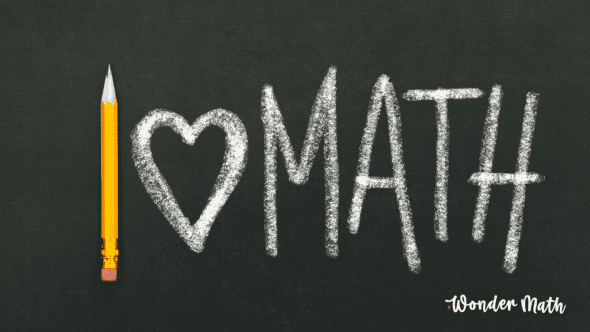
Math Programs 101: What Every Parent Should Know When Looking For A Math Program
As a parent, you know that a solid foundation in mathematics is crucial for your child’s success, both in school and in life. But with so many math programs and math help services out there, how do you choose the right one? Whether you’re considering Outschool classes, searching for “math tutoring near me,” or exploring tutoring services online, understanding…
Mastery-Aligned Maths Tutoring
“The best thing has been the increase in confidence and tutors being there to deal with any misunderstandings straight away."
FREE daily maths challenges
A new KS2 maths challenge every day. Perfect as lesson starters - no prep required!

Maths Problem Solving: Engaging Your Students And Strengthening Their Mathematical Skills
Meriel Willatt
Maths problem solving can be challenging for pupils. There’s no ‘one size fits all’ approach or strategy and questions often combine different topic areas. Pupils often don’t know where to start. It’s no surprise that problem solving is a common topic teachers struggle to teach effectively to their pupils.
In this blog, we consider the importance of problem solving and share with you some ideas and resources for you to tackle problem solving in your maths classroom, from KS2 up to GCSE.
What is maths problem solving?
Why is maths problem solving so difficult, how to develop problem solving skills in maths, maths problem solving ks2, maths problem solving ks3, maths problem solving gcse.
Maths problem solving is when a mathematical task challenges pupils to apply their knowledge, logic and reasoning in unfamiliar contexts. Problem solving questions often combine several elements of maths.
We know from talking to the hundreds of school leaders and maths teachers that we work with as one to one online maths tutoring providers that this is one of their biggest challenges: equipping pupils with the skills and confidence necessary to approach problem solving questions.
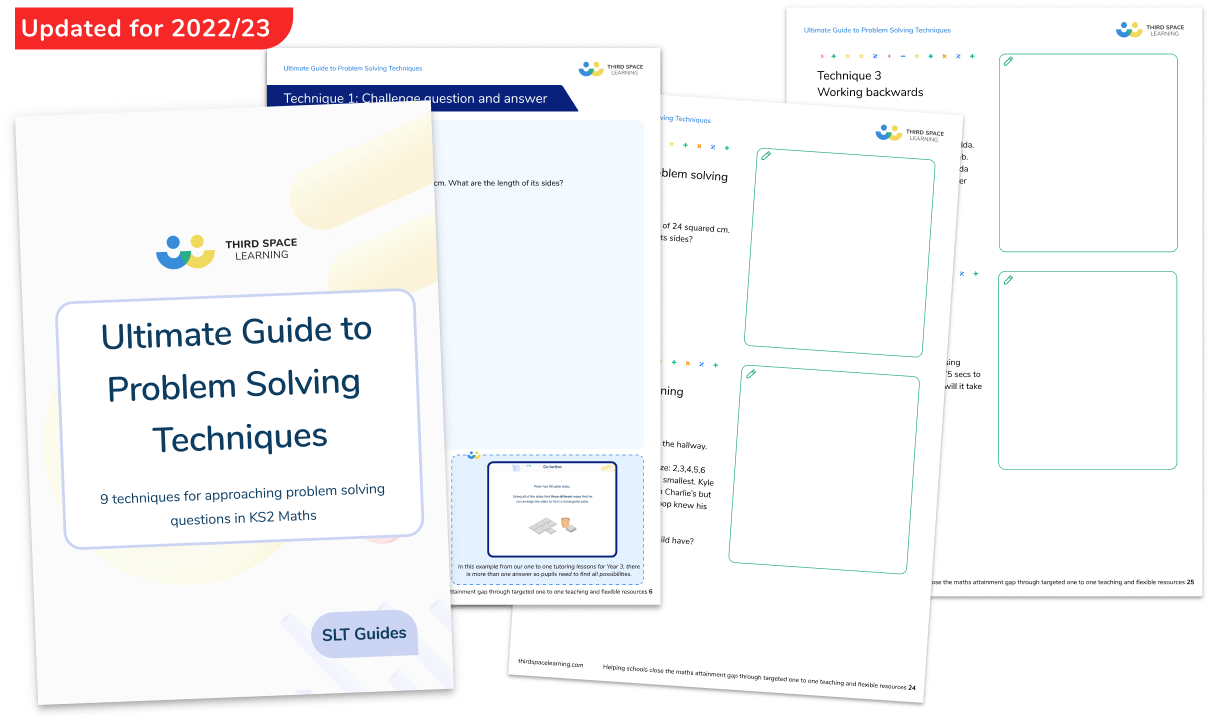
The Ultimate Guide to Problem Solving Techniques
Download these 9 ready-to-go problem solving techniques that every pupil should know
The challenge with problem solving in maths is that there is no generic problem solving skill that can be taught in an isolated maths lesson. It’s a skill that teachers must explicitly teach to pupils, embed into their learning and revisit often.
When pupils are first introduced to a topic, they cannot start problem solving straight away using it. Problem solving relies on deep knowledge of concepts. Pupils need to become familiar with it and practice using it in different contexts before they can make connections, reason and problem solve with it. In fact, some researchers suggest that it could take up to two years to do this (Burkhardt, 2017).
At Third Space Learning, we specialise in online one to one maths tutoring for schools, from KS1 all the way up to GCSE. Our lessons are designed by maths teachers and pedagogy experts to break down complex problems into their constituent parts. Our specialist tutors then carefully scaffold learning to build students’ confidence in key skills before combining them to tackle problem solving questions.
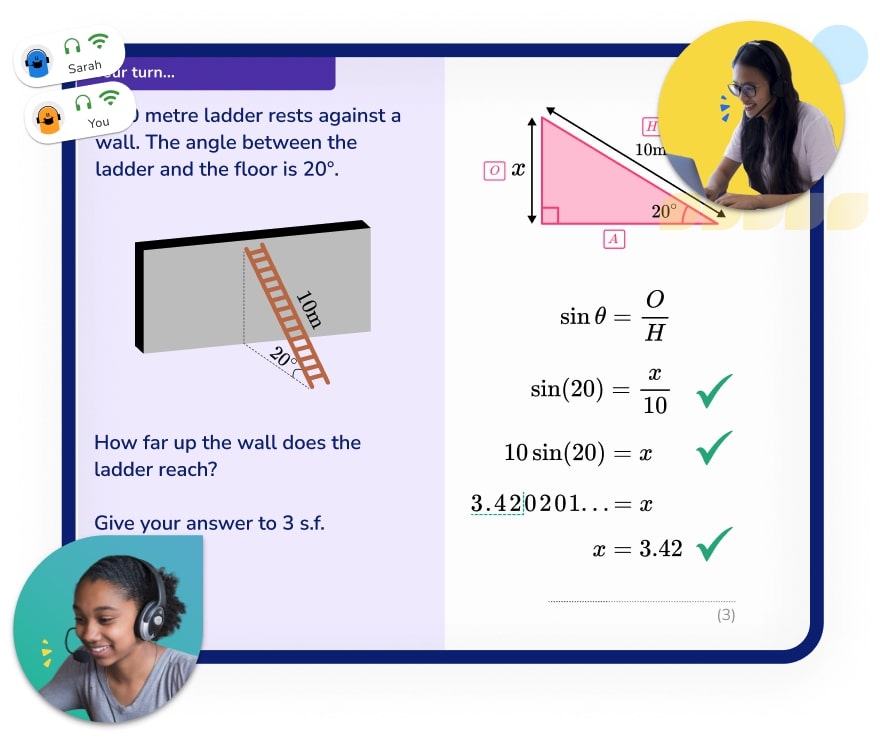
In order to develop problem solving skills in maths, pupils need lots of different contexts and word problems in which to practise them and the opportunity to engage in mathematical talk that draws on their metacognitive skills.
The EEF suggests that to develop problem solving skills in maths, teachers need to teach pupils:
- To use different approaches to problem solving
- Use worked examples
- To use metacognition to plan, monitor and reflect on their approaches to problem solving
Below, we take a closer look at problem solving at each stage, from primary school all the way to GCSEs. We’ve also included links to maths resources and CPD to support you and your team’s classroom teaching.
At lower KS2, the National Curriculum states that pupils should develop their ability to solve a range of problems. However, these will involve simple calculations as pupils develop their numeracy skills. As pupils progress to upper KS2, the demand for problem solving skills increases.
“At this stage, pupils should develop their ability to solve a wider range of problems, including increasingly complex properties of numbers and arithmetic, and problems demanding efficient written and mental methods of calculation. With this foundation in arithmetic, pupils are introduced to the language of algebra as a means for solving a variety of problems.” National curriculum in England: mathematics programmes of study (Upper key stage 2 – years 5 and 6)
KS2 problem solving can often fall into the trap of relying on acronyms, such as RICE, RIDE or even QUACK. The most popular is RUCSAC (Read, Underline, Calculate, Solve, Answer, Check). While these do aim to simplify the process for young minds, it encourages a superficial, formulaic approach to problem solving, rather than deep mathematical thinking. Also, consider how much is wrapped up within the word ‘solve’ – is this helpful?
We teach thousands of pupils KS2 maths problem solving skills every week through our one to one online tutoring programme for maths. In our interventions, we encourage deep mathematical thinking by using a simplified version of George Polya’s four stages of problem solving. Here are the four stages:
Understand the problem
- Devise a strategy for solving it
- Carry out the problem solving strategy
- Check the result
We use UCR as a simplified model: Understand, Communicate & Reflect. You may choose to adapt this depending on the age and ability of your class.
For example:
Maisy, Heidi and Freddie are children in the same family. The product of their ages is a score. How old might they be?
There are three people.
There are three numbers that multiply together to make twenty (a score is equal to 20). There will be lots of answers, but no ‘right’ answer.
Communicate
To solve the word problem we need to find the numbers that will go into 20 without a remainder (the factors).
The factors of 20 are 1, 2, 4, 5, 10 and 20.
Combinations of numbers that could work are: 1, 1, 20 1, 2, 10 1, 4, 5 2, 2, 5.
The question says children, which means ‘under 18 years’, so that would mean we could remove 1, 1, 20 from our list of possibilities.
In our sessions, we create a nurturing learning environment where pupils feel safe to make mistakes. This is so important in the context of problem solving as the best problem solvers will be resilient and able to overcome challenges in the ‘Reflect’ stage. Read more: What is a growth mindset
Looking for more support teaching KS2 problem solving? We’ve developed a powerpoint on problem solving, reasoning and planning for depth that is designed to be used as CPD by primary school teachers, maths leads and SLT.
The resource reflects on how metacognition can enhance reasoning and problem solving abilities, the ‘curse’ of real life maths (think ‘Carl buys 60 watermelons…) and how teachers can practically implement and teach strategies in the classroom.
You may also be interested in:
- Developing Thinking Skills At KS2
- KS2 Maths Investigations
- Word problems for Year 6
At KS3, the importance of seeing mathematical concepts as interconnected with other skills, including problem solving, is foregrounded. The National Curriculum also stresses the importance of a strong foundation in maths before moving on to complex problem solving.
“Mathematics is an interconnected subject in which pupils need to be able to move fluently between representations of mathematical ideas. The programme of study for key stage 3 is organised into apparently distinct domains, but pupils should build on key stage 2 and connections across mathematical ideas to develop fluency, mathematical reasoning and competence in solving increasingly sophisticated problems” National curriculum in England: mathematics programmes of study (Key stage 3)
“Decisions about progression should be based on the security of pupils’ understanding and their readiness to progress to the next stage. Pupils who grasp concepts rapidly should be challenged through being offered rich and sophisticated problems before any acceleration through new content in preparation for key stage 4.” National curriculum in England: mathematics programmes of study (Key stage 3)
For many students, the transition from primary to secondary school can be a huge challenge.
Especially in the aftermath of the Covid-19 pandemic and the resultant school closures, students may arrive into Year 7 with various learning gaps and misconceptions that will hold them. Some students may need focused support to plug these gaps and grow in confidence.
You can give pupils a smoother transition from KS2 to KS3 with personalised one to one online tuition with specialist tutors with Third Space Learning. Our lessons cover content from Years 5-7 and build a solid foundation for pupils to develop their problem solving skills. Pupils are supported towards independent practice through worked examples, questioning and support slides.
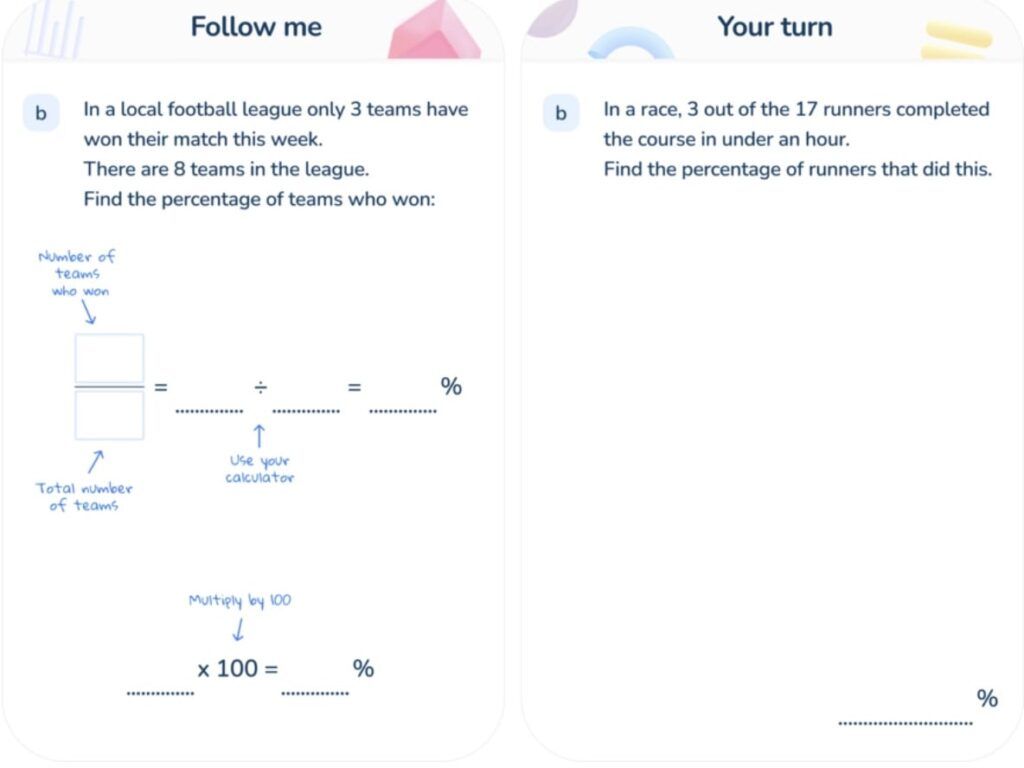
The challenge for KS3 maths problem solving activities is that learners may struggle to get invested unless you start with a convincing hook. Engage your young mathematicians on topics you know well or you know they’ll be invested in and try your hand at designing your own mathematical problems. Alternatively, get some inspiration from our crossover ability and fun maths problems .
Since the new GCSE specification began in 2015, there has been an increased focus on non-routine problem solving questions. These questions demand students to make sense of lots of new information at once before they even move on to selecting the strategies they’ll use to find the correct answer. This is where many learners get stuck.
In recent years, teachers and researchers in pedagogy (including Ofsted) have recognised that open ended problem solving tasks do not in fact lead to improved student understanding. While they may be enjoyable and engage learners, they may not lead to improved results.
SSDD problems (Same Surface Different Depth) can offer a solution that develops students’ critical thinking skills, while ensuring they engage fully with the information they’re provided. The idea behind them is to provide a set of questions that look the same and use the same mathematical hook but each question requires a different mathematical process to be solved.
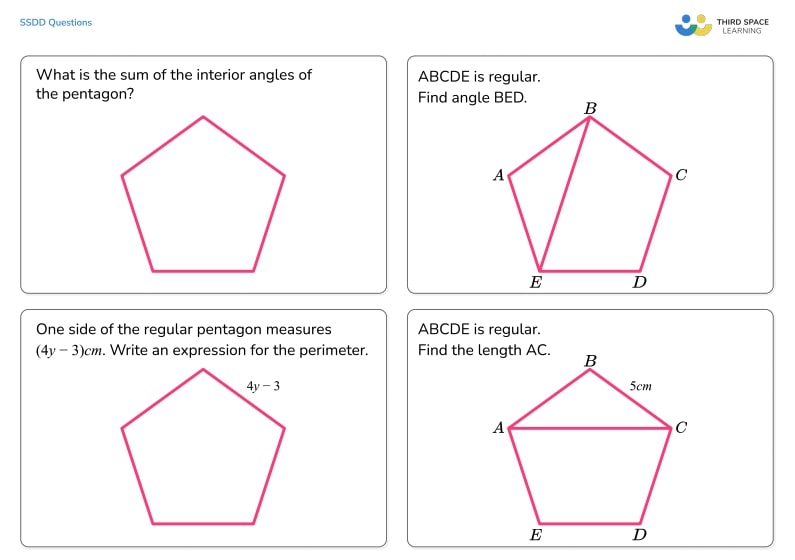
Read more about SSDD problems , tips on writing your own questions and download free printable examples. There are also plenty of more examples on the NRICH website.
Worked examples, careful questioning and constructing visual representations can help students to convert the information embedded in a maths challenge into mathematical notations. Read our blog on problem solving maths questions for Foundation, Crossover & Higher examples, worked solutions and strategies.
Remember that students can only move on to mathematics problem solving once they have secure knowledge in a topic. If you know there are areas your students need extra support, check our Secondary Maths Resources library for revision guides, teaching resources and worksheets for KS3 and GCSE topics.
DO YOU HAVE STUDENTS WHO NEED MORE SUPPORT IN MATHS?
Every week Third Space Learning’s specialist online maths tutors support thousands of students across hundreds of schools with weekly online 1 to 1 maths lessons designed to plug gaps and boost progress.
Since 2013 these personalised one to 1 lessons have helped over 150,000 primary and secondary students become more confident, able mathematicians.
Learn how the programmes are aligned to maths mastery teaching or request a personalised quote for your school to speak to us about your school’s needs and how we can help.
Related articles

Free Year 7 Maths Test With Answers And Mark Scheme: Mixed Topic Questions

What Is A Number Square? Explained For Primary School Teachers, Parents & Pupils
What Is Numicon? Explained For Primary School Teachers, Parents And Pupils

30 Problem Solving Maths Questions And Answers For GCSE
FREE Guide to Maths Mastery
All you need to know to successfully implement a mastery approach to mathematics in your primary school, at whatever stage of your journey.
Ideal for running staff meetings on mastery or sense checking your own approach to mastery.
Privacy Overview
- Skip to main content
- Skip to primary sidebar
- Skip to footer
Additional menu
Khan Academy Blog
Unlocking the Power of Math Learning: Strategies and Tools for Success
posted on September 20, 2023

Mathematics, the foundation of all sciences and technology, plays a fundamental role in our everyday lives. Yet many students find the subject challenging, causing them to shy away from it altogether. This reluctance is often due to a lack of confidence, a misunderstanding of unclear concepts, a move ahead to more advanced skills before they are ready, and ineffective learning methods. However, with the right approach, math learning can be both rewarding and empowering. This post will explore different approaches to learning math, strategies for success, and cutting-edge tools to help you achieve your goals.
Math Learning
Math learning can take many forms, including traditional classroom instruction, online courses, and self-directed learning. A multifaceted approach to math learning can improve understanding, engage students, and promote subject mastery. A 2014 study by the National Council of Teachers of Mathematics found that the use of multiple representations, such as visual aids, graphs, and real-world examples, supports the development of mathematical connections, reasoning, and problem-solving skills.
Moreover, the importance of math learning goes beyond solving equations and formulas. Advanced math skills are essential for success in many fields, including science, engineering, finance, health care, and technology. In fact, a report by Burning Glass Technologies found that 71% of high-salary, entry-level positions require advanced math skills.
Benefits of Math Learning
In today’s 21st-century world, having a broad knowledge base and strong reading and math skills is essential. Mathematical literacy plays a crucial role in this success. It empowers individuals to comprehend the world around them and make well-informed decisions based on data-driven understanding. More than just earning good grades in math, mathematical literacy is a vital life skill that can open doors to economic opportunities, improve financial management, and foster critical thinking. We’re not the only ones who say so:
- Math learning enhances problem-solving skills, critical thinking, and logical reasoning abilities. (Source: National Council of Teachers of Mathematics )
- It improves analytical skills that can be applied in various real-life situations, such as budgeting or analyzing data. (Source: Southern New Hampshire University )
- Math learning promotes creativity and innovation by fostering a deep understanding of patterns and relationships. (Source: Purdue University )
- It provides a strong foundation for careers in fields such as engineering, finance, computer science, and more. These careers generally correlate to high wages. (Source: U.S. Bureau of Labor Statistics )
- Math skills are transferable and can be applied across different academic disciplines. (Source: Sydney School of Education and Social Work )
How to Know What Math You Need to Learn
Often students will find gaps in their math knowledge; this can occur at any age or skill level. As math learning is generally iterative, a solid foundation and understanding of the math skills that preceded current learning are key to success. The solution to these gaps is called mastery learning, the philosophy that underpins Khan Academy’s approach to education .
Mastery learning is an educational philosophy that emphasizes the importance of a student fully understanding a concept before moving on to the next one. Rather than rushing students through a curriculum, mastery learning asks educators to ensure that learners have “mastered” a topic or skill, showing a high level of proficiency and understanding, before progressing. This approach is rooted in the belief that all students can learn given the appropriate learning conditions and enough time, making it a markedly student-centered method. It promotes thoroughness over speed and encourages individualized learning paths, thus catering to the unique learning needs of each student.
Students will encounter mastery learning passively as they go through Khan Academy coursework, as our platform identifies gaps and systematically adjusts to support student learning outcomes. More details can be found in our Educators Hub .
Try Our Free Confidence Boosters
How to learn math.
Learning at School
One of the most common methods of math instruction is classroom learning. In-class instruction provides students with real-time feedback, practical application, and a peer-learning environment. Teachers can personalize instruction by assessing students’ strengths and weaknesses, providing remediation when necessary, and offering advanced instruction to students who need it.
Learning at Home
Supplemental learning at home can complement traditional classroom instruction. For example, using online resources that provide additional practice opportunities, interactive games, and demonstrations, can help students consolidate learning outside of class. E-learning has become increasingly popular, with a wealth of online resources available to learners of all ages. The benefits of online learning include flexibility, customization, and the ability to work at one’s own pace. One excellent online learning platform is Khan Academy, which offers free video tutorials, interactive practice exercises, and a wealth of resources across a range of mathematical topics.
Moreover, parents can encourage and monitor progress, answer questions, and demonstrate practical applications of math in everyday life. For example, when at the grocery store, parents can ask their children to help calculate the price per ounce of two items to discover which one is the better deal. Cooking and baking with your children also provides a lot of opportunities to use math skills, like dividing a recipe in half or doubling the ingredients.
Learning Math with the Help of Artificial Intelligence (AI)
AI-powered tools are changing the way students learn math. Personalized feedback and adaptive practice help target individual needs. Virtual tutors offer real-time help with math concepts while AI algorithms identify areas for improvement. Custom math problems provide tailored practice, and natural language processing allows for instant question-and-answer sessions.
Using Khan Academy’s AI Tutor, Khanmigo
Transform your child’s grasp of mathematics with Khanmigo , the 24/7 AI-powered tutor that specializes in tailored, one-on-one math instruction. Available at any time, Khanmigo provides personalized support that goes beyond mere answers to nurture genuine mathematical understanding and critical thinking. Khanmigo can track progress, identify strengths and weaknesses, and offer real-time feedback to help students stay on the right track. Within a secure and ethical AI framework, your child can tackle everything from basic arithmetic to complex calculus, all while you maintain oversight using robust parental controls.
Get Math Help with Khanmigo Right Now
You can learn anything .
Math learning is essential for success in the modern world, and with the right approach, it can also be enjoyable and rewarding. Learning math requires curiosity, diligence, and the ability to connect abstract concepts with real-world applications. Strategies for effective math learning include a multifaceted approach, including classroom instruction, online courses, homework, tutoring, and personalized AI support.
So, don’t let math anxiety hold you back; take advantage of available resources and technology to enhance your knowledge base and enjoy the benefits of math learning.
National Council of Teachers of Mathematics, “Principles to Actions: Ensuring Mathematical Success for All” , April 2014
Project Lead The Way Research Report, “The Power of Transportable Skills: Assessing the Demand and Value of the Skills of the Future” , 2020
Page. M, “Why Develop Quantitative and Qualitative Data Analysis Skills?” , 2016
Mann. EL, Creativity: The Essence of Mathematics, Journal for the Education of the Gifted. Vol. 30, No. 2, 2006, pp. 236–260, http://www.prufrock.com ’
Nakakoji Y, Wilson R.” Interdisciplinary Learning in Mathematics and Science: Transfer of Learning for 21st Century Problem Solving at University ”. J Intell. 2020 Sep 1;8(3):32. doi: 10.3390/jintelligence8030032. PMID: 32882908; PMCID: PMC7555771.
Get Khanmigo
The best way to learn and teach with AI is here. Ace the school year with our AI-powered guide, Khanmigo.
For learners For teachers For parents
- 1st Grade Math
- 2nd Grade Math
- 3rd Grade Math
- 4th Grade Math
- 5th Grade Math
- 6th Grade Math
- 7th Grade Math
- 8th Grade Math
- Knowledge Base
- Math for kids
10 Strategies for Problem Solving in Math
May 19, 2022
8 minutes read

When faced with problem-solving, children often get stuck. Word puzzles and math questions with an unknown variable, like x, usually confuse them. Therefore, this article discusses math strategies and how your students may use them since instructors often have to lead students through this problem-solving maze.
What Are Problem Solving Strategies in Math?
If you want to fix a problem, you need a solid plan. Math strategies for problem solving are ways of tackling math in a way that guarantees better outcomes. These strategies simplify math for kids so that less time is spent figuring out the problem. Both those new to mathematics and those more knowledgeable about the subject may benefit from these methods.
There are several methods to apply problem-solving procedures in math, and each strategy is different. While none of these methods failsafe, they may help your student become a better problem solver, particularly when paired with practice and examples. The more math problems kids tackle, the more math problem solving skills they acquire, and practice is the key.
Strategies for Problem-solving in Math
Even if a student is not a math wiz, a suitable solution to mathematical problems in math may help them discover answers. There is no one best method for helping students solve arithmetic problems, but the following ten approaches have shown to be very effective.
Understand the Problem
Understanding the nature of math problems is a prerequisite to solving them. They need to specify what kind of issue it is ( fraction problem , word problem, quadratic equation, etc.). Searching for keywords in the math problem, revisiting similar questions, or consulting the internet are all great ways to strengthen their grasp of the material. This step keeps the pupil on track.
1:1 Math Lessons
Want to raise a genius? Start learning Math with Brighterly
Guess and check.
One of the time-intensive strategies for resolving mathematical problems is the guess and check method. In this approach, students keep guessing until they get the answer right.
After assuming how to solve a math issue, students should reintroduce that assumption to check for correctness. While the approach may appear cumbersome, it is typically successful in revealing patterns in a child’s thought process.
Work It Out
Encourage pupils to record their thinking process as they go through a math problem. Since this technique requires an initial comprehension of the topic, it serves as a self-monitoring method for mathematics students. If they immediately start solving the problem, they risk making mistakes.
Students may keep track of their ideas and fix their math problems as they go along using this method. A youngster may still need you to explain their methods of solving the arithmetic questions on the extra page. This confirmation stage etches the steps they took to solve the problem in their minds.
Work Backwards
In mathematics, a fresh perspective is sometimes the key to a successful solution. Young people need to know that the ability to recreate math problems is valuable in many professional fields, including project management and engineering.
Students may better prepare for difficulties in real-world circumstances by using the “Work Backwards” technique. The end product may be used as a start-off point to identify the underlying issue.
In most cases, a visual representation of a math problem may help youngsters understand it better. Some of the most helpful math tactics for kids include having them play out the issue and picture how to solve it.
One way to visualize a workout is to use a blank piece of paper to draw a picture or make tally marks. Students might also use a marker and a whiteboard to draw as they demonstrate the technique before writing it down.
Find a Pattern
Kids who use pattern recognition techniques can better grasp math concepts and retain formulae. The most remarkable technique for problem solving in mathematics is to help students see patterns in math problems by instructing them how to extract and list relevant details. This method may be used by students when learning shapes and other topics that need repetition.
Students may use this strategy to spot patterns and fill in the blanks. Over time, this strategy will help kids answer math problems quickly.
When faced with a math word problem, it might be helpful to ask, “What are some possible solutions to this issue?” It encourages you to give the problem more thought, develop creative solutions, and prevent you from being stuck in a rut. So, tell the pupils to think about the math problems and not just go with the first solution that comes to mind.
Draw a Picture or Diagram
Drawing a picture of a math problem can help kids understand how to solve it, just like picturing it can help them see it. Shapes or numbers could be used to show the forms to keep things easy. Kids might learn how to use dots or letters to show the parts of a pattern or graph if you teach them.
Charts and graphs can be useful even when math isn’t involved. Kids can draw pictures of the ideas they read about to help them remember them after they’ve learned them. The plan for how to solve the mathematical problem will help kids understand what the problem is and how to solve it.
Trial and Error Method
The trial and error method may be one of the most common problem solving strategies for kids to figure out how to solve problems. But how well this strategy is used will determine how well it works. Students have a hard time figuring out math questions if they don’t have clear formulas or instructions.
They have a better chance of getting the correct answer, though, if they first make a list of possible answers based on rules they already know and then try each one. Don’t be too quick to tell kids they shouldn’t learn by making mistakes.
Review Answers with Peers
It’s fun to work on your math skills with friends by reviewing the answers to math questions together. If different students have different ideas about how to solve the same problem, get them to share their thoughts with the class.
During class time, kids’ ways of working might be compared. Then, students can make their points stronger by fixing these problems.
Check out the Printable Math Worksheets for Your Kids!
There are different ways to solve problems that can affect how fast and well students do on math tests. That’s why they need to learn the best ways to do things. If students follow the steps in this piece, they will have better experiences with solving math questions.

Jessica is a a seasoned math tutor with over a decade of experience in the field. With a BSc and Master’s degree in Mathematics, she enjoys nurturing math geniuses, regardless of their age, grade, and skills. Apart from tutoring, Jessica blogs at Brighterly. She also has experience in child psychology, homeschooling and curriculum consultation for schools and EdTech websites.

As adults, we take numbers for granted, but preschoolers and kindergartners have no idea what these symbols mean. Yet, we often demand instant understanding and flawless performance when we start teaching numbers to our children. If you don’t have a clue about how to teach numbers for kids, browse no more. You will get four […]

Teaching children is a complex process because they require more attention than an adult person. You may need to employ different teaching strategies when teaching kids. But what are teaching strategies? Teaching strategies are the methods to ensure your kids or students learn efficiently. But not all strategies yield similarly, and if the one you […]
Book 1 to 1 Math Lesson
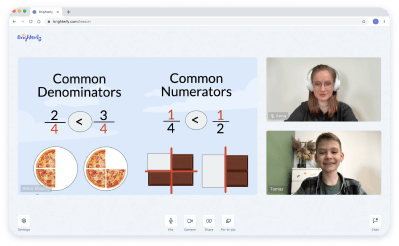
Kid’s grade
After-School Math Program Boost Your Child's Math Abilities! Ideal for 1st-12th Graders, Perfectly Synced with School Curriculum!

After-School Math Program
Related posts.
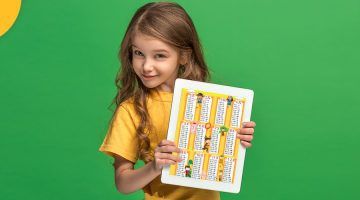
Tricks for Learning Multiplication Tables Memorization Techniques
When it comes to elementary math, multiplication is a real challenge. Fortunately, memorizing times tables allows one to solve problems more quickly, which is an essential skill in real life. This article will detail the easiest techniques and how to memorize the multiplication table, whether you’re a teacher looking for tips on teaching multiplication tables […]
Apr 05, 2022

51 Easy Math Riddles for Kids to Make Math Learning Fun
It is not surprising that kids find math boring, seeing as adults do, too. However, you can always make things much more fun for kids by engaging in math activities like math riddles for kids that boost their concentration and keep them engaged. Before we go to the fun math riddles for kids, here are […]
Mar 23, 2022

The Benefits of One on One Tutoring for Kids’ Development
Schools have changed significantly over the years, both in terms of structure and the process of learning. After-school support to boost kids’ performance has become more necessary. Knowing that extra help will set their kids on the path to mastery of school subjects, parents enlist professional tutors. So, if you are looking to do the […]
May 25, 2022
We use cookies to help give you the best service possible. If you continue to use the website we will understand that you consent to the Terms and Conditions. These cookies are safe and secure. We will not share your history logs with third parties. Learn More
- Grade 1 Lessons
- Grade 2 Lessons
- Grade 3 Lessons
- Grade 4 Lessons
- Grade 5 Lessons
- Math Activities
How to Improve Problem-Solving Skills in Math
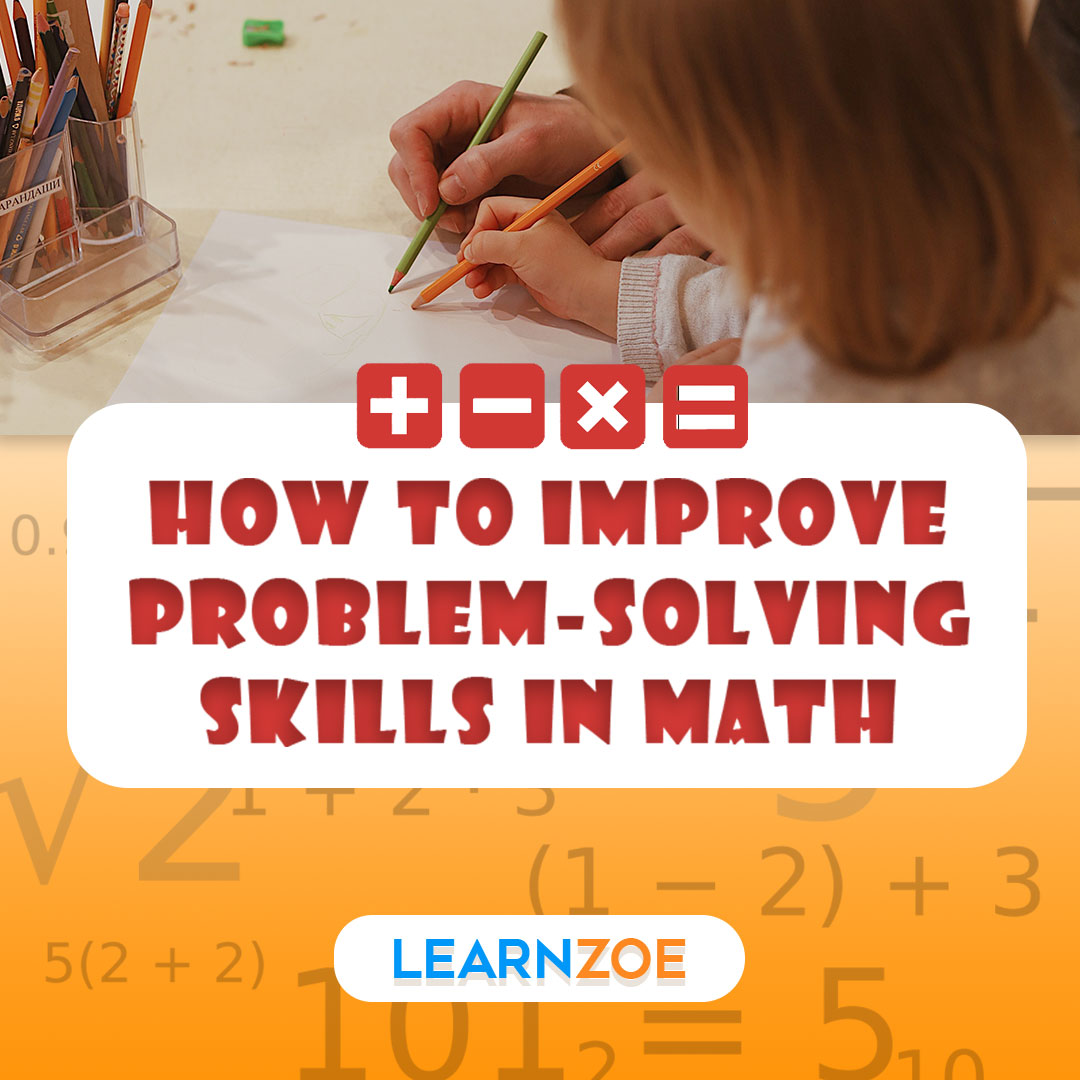
Importance of Problem-Solving Skills in Math
Problem-solving skills are crucial in math education , enabling students to apply mathematical concepts and principles to real-world situations. Here’s why problem-solving skills are essential in math education:
1. Application of knowledge: Problem-solving in math requires encouraging students to apply the knowledge they acquire in the classroom to tackle real-life problems. It helps them understand the relevance of math in everyday life and enhances their critical thinking skills.
2. Developing critical thinking: Problem-solving requires students to analyze, evaluate, and think critically about different approaches and strategies to solve a problem. It strengthens their mathematical abilities and improves their overall critical thinking skills.
3. Enhancing problem-solving skills: Math problems often have multiple solutions, encouraging students to think creatively and explore different problem-solving strategies. It helps develop their problem-solving skills, which are valuable in various aspects of life beyond math.
4. Fostering perseverance: Problem-solving in math often requires persistence and resilience. Students must be willing to try different approaches, learn from their mistakes, and keep trying until they find a solution. It fosters a growth mindset and teaches them the value of perseverance.
Benefits of strong problem-solving skills
Having strong problem-solving skills in math offers numerous benefits for students:
1. Improved academic performance: Students with strong problem-solving skills are likelier to excel in math and other subjects that rely on logical reasoning and critical thinking.
2. Enhanced problem-solving abilities: Strong problem-solving skills extend beyond math and can be applied to various real-life situations. It includes decision-making, analytical thinking, and solving complex problems creatively.
3. Increased confidence: Successfully solving math problems boosts students’ self-confidence and encourages them to tackle more challenging tasks. This confidence spills over into other areas of their academic and personal lives.
4. Preparation for future careers: Problem-solving skills are highly sought after by employers in various fields. Developing strong problem-solving skills in math sets students up for successful careers in engineering, technology, finance, and more.
Problem-solving skills are essential for math education and have numerous benefits for students. By fostering these skills, educators can empower students to become confident, critical thinkers who can apply their mathematical knowledge to solve real-world problems.
Understand the Problem
Breaking down the problem and identifying the key components.
To improve problem-solving math skills, it’s essential to first understand the problem at hand. Here are some tips to help break down the problem and identify its key components:
1. Read the problem carefully: Take your time to read it attentively and ensure you understand what it asks. Pay attention to keywords or phrases that indicate what mathematical operation or concept to use.
2. Identify the known and unknown variables: Determine what information is already given in the problem (known variables) and what you need to find (unknown variables). This step will help you analyze the problem more effectively.
3. Define the problem in your own words: Restate the problem using your own words to ensure you clearly understand what needs to be solved. It can help you focus on the main objective and eliminate any distractions.
4. Break the problem into smaller parts: Complex math problems can sometimes be overwhelming. Breaking them down into smaller, manageable parts can make them more approachable. Identify any sub-problems or intermediate steps that must be solved before reaching the final solution.
Reading and interpreting math word problems effectively
Many math problems are presented as word problems requiring reading and interpreting skills. Here are some strategies to help you effectively understand and solve math word problems:
1. Highlight key information: As you read the word problem, underline or highlight any important details, such as numbers, units of measurement, or specific keywords related to mathematical operations.
2. Visualize the problem: Create visual representations, such as diagrams or graphs, to help you understand the problem better. Visualizing the problem can make determining what steps to take and how to approach the solution easier.
3. Translate words into equations: Convert the information in the word problem into mathematical equations or expressions. This translation step helps you transform the problem into a solvable math equation.
4. Solve step by step: Break down the problem into smaller steps and solve each step individually. This approach helps you avoid confusion and progress toward the correct solution.
Improving problem-solving skills in math requires practice and patience. By understanding the problem thoroughly, breaking it into manageable parts, and effectively interpreting word problems, you can confidently enhance your ability to solve math problems.
Use Visual Representations
Using diagrams, charts, and graphs to visualize the problem.
One effective way to improve problem-solving skills in math is to utilize visual representations. Visual representations , such as diagrams, charts, and graphs, can help make complex problems more tangible and easily understood. Here are some ways to use visual representations in problem-solving:
1. Draw Diagrams: When faced with a word problem or a complex mathematical concept, drawing a diagram can help break down the problem into more manageable parts. For example, suppose you are dealing with a geometry problem. In that case, sketching the shapes involved can provide valuable insights and help you visualize the problem better.
2. Create Charts or Tables: For problems that involve data or quantitative information, creating charts or tables can help organize the data and identify patterns or trends. It can be particularly useful in analyzing data from surveys, experiments, or real-life scenarios.
3. Graphical Representations: Graphs can be powerful tools in problem-solving, especially when dealing with functions, equations, or mathematical relationships. Graphically representing data or equations makes it easier to identify key features that may be hard to spot from a numerical representation alone, such as intercepts or trends.
Benefits of visual representation in problem-solving
Using visual representations in problem-solving offers several benefits:
1. Enhances Comprehension: Visual representations provide a visual context for abstract mathematical concepts, making them easier to understand and grasp.
2. Encourages Critical Thinking: Visual representations require active engagement and critical thinking skills. Students can enhance their problem-solving and critical thinking abilities by analyzing and interpreting visual data.
3. Promotes Pattern Recognition: Visual representations simplify identifying patterns, trends, and relationships within data or mathematical concepts. It can lead to more efficient problem-solving and a deeper understanding of mathematical principles.
4. Facilitates Communication: Visual representations can be shared and discussed, helping students communicate their thoughts and ideas effectively. It can be particularly useful in collaborative problem-solving environments.
Incorporating visual representations into math problem-solving can significantly enhance understanding, critical thinking, pattern recognition, and communication skills. Students can approach math problems with a fresh perspective and improve their problem-solving abilities using visual tools.
Work Backwards
Understanding the concept of working backward in math problem-solving.
Working backward is a problem-solving strategy that starts with the solution and returns to the given problem. This approach can be particularly useful in math, as it helps students break down complex problems into smaller, more manageable steps. Here’s how to apply the concept of working backward in math problem-solving:
1. Identify the desired outcome : Start by clearly defining the goal or solution you are trying to reach. It could be finding the value of an unknown variable, determining a specific measurement, or solving for a particular quantity.
2. Visualize the result : Imagine the final step or solution. It will help you create a mental image of the steps needed to reach that outcome.
3. Trace the steps backward : Break down the problem into smaller steps, working backward from the desired outcome. Think about what needs to happen immediately before reaching the final solution and continue tracing the steps back to the beginning of the problem.
4. Check your work : Once you have worked backward to the beginning of the problem, double-check your calculations and steps to ensure accuracy.
Real-life examples and applications of working backward
Working backward is a valuable problem-solving technique in math and has real-life applications. Here are a few examples:
1. Financial planning : When creating a budget, you can work backward by determining your desired savings or spending amount and then calculating how much income or expenses are needed to reach that goal.
2. Project management : When planning a project, you can work backward by setting a fixed deadline and then determining the necessary steps and timelines to complete the project on time.
3. Game strategy : In games like chess or poker, working backward can help you anticipate your opponent’s moves and plan your strategy accordingly.
4. Recipe adjustments : When modifying a recipe, you can work backward by envisioning the final taste or texture you want to achieve and adjusting the ingredients or cooking methods accordingly.
By practicing working backward in math and applying it to real-life situations, you can enhance your problem-solving abilities and find creative solutions to various challenges.
Try Different Strategies
When solving math problems, it’s essential to have a repertoire of problem-solving strategies. You can improve your problem-solving skills and tackle various mathematical challenges by trying different approaches. Here are some strategies to consider:
Exploring Various Problem-Solving Strategies
1. Guess and Check: This strategy involves making an educated guess and checking if it leads to the correct solution. It can be useful when dealing with trial-and-error problems.
2. Drawing a Diagram: Visually representing the problem through diagrams or graphs can help you understand and solve it more effectively. This strategy is particularly useful in geometry and algebraic reasoning.
3. Using Logic: Using logical reasoning is useful for breaking down complicated problems into smaller, more manageable components. This strategy is especially useful in mathematical proofs and logical puzzles.
4. Working Backwards: Start with the desired outcome and return to the given information. When dealing with equations or word problems, this approach can assist.
5. Using Patterns: Look for patterns and relationships within the problem to determine a solution. This approach can be used for different mathematical problems, such as sequences and numerical patterns.
When and How to Apply Different Strategies in Math Problem-Solving
Knowing when and how to apply different problem-solving strategies is crucial for success in math. Here are some tips:
- Understand the problem: Read the problem carefully and identify the key information and requirements.
- Select an appropriate strategy: Choose the most appropriate problem-solving strategy for the problem.
- Apply the chosen strategy: Implement the selected strategy, following the necessary steps.
- Check your solution: Verify your answer by double-checking the calculations or applying alternative methods.
- Reflect on the process: After solving the problem, take a moment to reflect and evaluate your problem-solving approach. Identify areas for improvement and consider alternative strategies that could have been used.
By exploring different problem-solving strategies and applying them to various math problems, you can enhance your problem-solving skills and develop a versatile toolkit for tackling mathematical challenges. Practice and persistence are key to honing your problem-solving abilities in math.
Key takeaways and tips for improving problem-solving skills in math
In conclusion, developing strong problem-solving skills in math is crucial for success in this subject. Here are some key takeaways and tips to help you improve your problem-solving abilities:
- Practice regularly: The more you practice solving math problems, the better you will become at identifying patterns, applying strategies, and finding solutions.
- Break down the problem: When faced with a complex math problem, break it into smaller, more manageable parts. It will make it easier to understand and solve.
- Understand the problem: Before diving into a solution, fully understand the problem. Identify what information is given and what you are asked to find.
- Draw diagrams or visualize: Use visual aids, such as diagrams or sketches, to help you better understand the problem and visualize the solution.
- Use logical reasoning: Apply logical reasoning skills to analyze the problem and determine the most appropriate approach or strategy.
- Try different strategies: If one approach doesn’t work, don’t be afraid to try different strategies or methods. There are often multiple ways to solve a math problem.
- Seek help and collaborate: Don’t hesitate to seek help from your teacher, classmates, or online resources. Collaborating with others can provide different perspectives and insights.
- Learn from mistakes: Mistakes are a valuable learning opportunity. Analyze your mistakes, understand where you went wrong, and learn from them to avoid making the same errors in the future.
- Grade 6 Lessons
- Grade 7 Lessons
- Grade 8 Lessons
- Kindergarten
- Math Lessons Online
- Math Tutorial
- Multiplication
- Subtraction
- #basic mathematic
- #Basic Mathematical Operation
- #best math online math tutor
- #Best Math OnlineTutor
- #dividing fractions
- #effective teaching
- #grade 8 math lessons
- #linear equation
- #Math Online Blog
- #mathematical rule
- #mutiplying fractions
- #odd and even numbers
- #Online Math Tutor
- #online teaching
- #order of math operations
- #pemdas rule
- #Point-Slope Form
- #Precalculus
- #Slope-Intercept Form
- #Tutoring Kids

Thank you for signing up!
GET IN TOUCH WITH US
- Our Mission
6 Tips for Teaching Math Problem-Solving Skills
Solving word problems is tougher than computing with numbers, but elementary teachers can guide students to do the deep thinking involved.

A growing concern with students is the ability to problem-solve, especially with complex, multistep problems. Data shows that students struggle more when solving word problems than they do with computation , and so problem-solving should be considered separately from computation. Why?
Consider this. When we’re on the way to a new destination and we plug in our location to a map on our phone, it tells us what lane to be in and takes us around any detours or collisions, sometimes even buzzing our watch to remind us to turn. When I experience this as a driver, I don’t have to do the thinking. I can think about what I’m going to cook for dinner, not paying much attention to my surroundings other than to follow those directions. If I were to be asked to go there again, I wouldn’t be able to remember, and I would again seek help.
If we can switch to giving students strategies that require them to think instead of giving them too much support throughout the journey to the answer, we may be able to give them the ability to learn the skills to read a map and have several ways to get there.
Here are six ways we can start letting students do this thinking so that they can go through rigorous problem-solving again and again, paving their own way to the solution.
1. Link problem-solving to reading
When we can remind students that they already have many comprehension skills and strategies they can easily use in math problem-solving, it can ease the anxiety surrounding the math problem. For example, providing them with strategies to practice, such as visualizing, acting out the problem with math tools like counters or base 10 blocks, drawing a quick sketch of the problem, retelling the story in their own words, etc., can really help them to utilize the skills they already have to make the task less daunting.
We can break these skills into specific short lessons so students have a bank of strategies to try on their own. Here's an example of an anchor chart that they can use for visualizing . Breaking up comprehension into specific skills can increase student independence and help teachers to be much more targeted in their problem-solving instruction. This allows students to build confidence and break down the barriers between reading and math to see they already have so many strengths that are transferable to all problems.
2. Avoid boxing students into choosing a specific operation
It can be so tempting to tell students to look for certain words that might mean a certain operation. This might even be thoroughly successful in kindergarten and first grade, but just like when our map tells us where to go, that limits students from becoming deep thinkers. It also expires once they get into the upper grades, where those words could be in a problem multiple times, creating more confusion when students are trying to follow a rule that may not exist in every problem.
We can encourage a variety of ways to solve problems instead of choosing the operation first. In first grade, a problem might say, “Joceline has 13 stuffed animals and Jordan has 17. How many more does Jordan have?” Some students might choose to subtract, but a lot of students might just count to find the amount in between. If we tell them that “how many more” means to subtract, we’re taking the thinking out of the problem altogether, allowing them to go on autopilot without truly solving the problem or using their comprehension skills to visualize it.
3. Revisit ‘representation’
The word “representation” can be misleading. It seems like something to do after the process of solving. When students think they have to go straight to solving, they may not realize that they need a step in between to be able to support their understanding of what’s actually happening in the problem first.
Using an anchor chart like one of these ( lower grade , upper grade ) can help students to choose a representation that most closely matches what they’re visualizing in their mind. Once they sketch it out, it can give them a clearer picture of different ways they could solve the problem.
Think about this problem: “Varush went on a trip with his family to his grandmother’s house. It was 710 miles away. On the way there, three people took turns driving. His mom drove 214 miles. His dad drove 358 miles. His older sister drove the rest. How many miles did his sister drive?”
If we were to show this student the anchor chart, they would probably choose a number line or a strip diagram to help them understand what’s happening.
If we tell students they must always draw base 10 blocks in a place value chart, that doesn’t necessarily match the concept of this problem. When we ask students to match our way of thinking, we rob them of critical thinking practice and sometimes confuse them in the process.
4. Give time to process
Sometimes as educators, we can feel rushed to get to everyone and everything that’s required. When solving a complex problem, students need time to just sit with a problem and wrestle with it, maybe even leaving it and coming back to it after a period of time.
This might mean we need to give them fewer problems but go deeper with those problems we give them. We can also speed up processing time when we allow for collaboration and talk time with peers on problem-solving tasks.
5. Ask questions that let Students do the thinking
Questions or prompts during problem-solving should be very open-ended to promote thinking. Telling a student to reread the problem or to think about what tools or resources would help them solve it is a way to get them to try something new but not take over their thinking.
These skills are also transferable across content, and students will be reminded, “Good readers and mathematicians reread.”
6. Spiral concepts so students frequently use problem-solving skills
When students don’t have to switch gears in between concepts, they’re not truly using deep problem-solving skills. They already kind of know what operation it might be or that it’s something they have at the forefront of their mind from recent learning. Being intentional within their learning stations and assessments about having a variety of rigorous problem-solving skills will refine their critical thinking abilities while building more and more resilience throughout the school year as they retain content learning in the process.
Problem-solving skills are so abstract, and it can be tough to pinpoint exactly what students need. Sometimes we have to go slow to go fast. Slowing down and helping students have tools when they get stuck and enabling them to be critical thinkers will prepare them for life and allow them multiple ways to get to their own destination.
- PRO Courses Guides New Tech Help Pro Expert Videos About wikiHow Pro Upgrade Sign In
- EDIT Edit this Article
- EXPLORE Tech Help Pro About Us Random Article Quizzes Request a New Article Community Dashboard This Or That Game Popular Categories Arts and Entertainment Artwork Books Movies Computers and Electronics Computers Phone Skills Technology Hacks Health Men's Health Mental Health Women's Health Relationships Dating Love Relationship Issues Hobbies and Crafts Crafts Drawing Games Education & Communication Communication Skills Personal Development Studying Personal Care and Style Fashion Hair Care Personal Hygiene Youth Personal Care School Stuff Dating All Categories Arts and Entertainment Finance and Business Home and Garden Relationship Quizzes Cars & Other Vehicles Food and Entertaining Personal Care and Style Sports and Fitness Computers and Electronics Health Pets and Animals Travel Education & Communication Hobbies and Crafts Philosophy and Religion Work World Family Life Holidays and Traditions Relationships Youth
- Browse Articles
- Learn Something New
- Quizzes Hot
- This Or That Game
- Train Your Brain
- Explore More
- Support wikiHow
- About wikiHow
- Log in / Sign up
- Education and Communications
- Mathematics
How to Improve Math Skills
Last Updated: April 15, 2024 Approved
This article was co-authored by Daron Cam and by wikiHow staff writer, Hannah Madden . Daron Cam is an Academic Tutor and the Founder of Bay Area Tutors, Inc., a San Francisco Bay Area-based tutoring service that provides tutoring in mathematics, science, and overall academic confidence building. Daron has over eight years of teaching math in classrooms and over nine years of one-on-one tutoring experience. He teaches all levels of math including calculus, pre-algebra, algebra I, geometry, and SAT/ACT math prep. Daron holds a BA from the University of California, Berkeley and a math teaching credential from St. Mary's College. wikiHow marks an article as reader-approved once it receives enough positive feedback. This article received 28 testimonials and 84% of readers who voted found it helpful, earning it our reader-approved status. This article has been viewed 412,376 times.
There’s no doubt about it: math is tough. As a result, a lot of kids (and adults!) struggle with math at some point in their lives. By building up your skills and practicing every day, you can make math a little less frustrating and have a higher chance of success. Use these tips and tricks during school, while you’re studying, and when you’re out and about to break down and complete math problems easily.
Play math games.

- DragonBox 5+ which lets you gradually build your algebra skills until you’re able to master more and more advanced equations.
- Prodigy, a game targeted at elementary-school students, that integrates math practice into a role-playing game that allows players to use math to make their way through an appealing fantasy world.
- Polyup, a calculator-based math game for more advanced high school and college students.
Practice math in everyday scenarios.

- Or, if you plan to hike a new trail that’s 7 miles long and it takes you 20 minutes to walk a mile, how long should you plan for your hike to take? (2 hours and 36 minutes).
Use mental math if you can.

- If you’re worried about your mental math skills, you can always double check your answer on your phone or computer.
Joseph Meyer
Develop your mental math skills. Mental math is when you perform mathematical calculations without using calculators, paper, or counting aids. Use your mind, memory, lessons, and discussions with your classmates to refine your math skills and build strong problem-solving strategies.
Review math concepts every day.

- Make note cards. Write out important concepts and formulas on note cards so that you can easily refer to them while doing problems and use them for study guides before exams.
- Study in a quiet place. Distractions, whether aural or visual, will detract both from your ability to pay attention and to retain information.
- Study when you’re alert and rested. Don’t try to force yourself to study late at night or when you’re sleep-deprived.
Show your work, not just your answers.

- Showing your work can also help you check your answers on homework and test problems.
- Don’t solve math problems with a pen! Use a pencil so you can erase and correct mistakes if they happen.
Sketch out word problems to give yourself a visual.

- For example, a problem might say, “If you have 4 pieces of candy split evenly into 2 bags, how many pieces of candy are in each bag?” You could draw 2 squares to represent the bags, then fill in 4 circles split between them to represent the candy.
Practice with example problems.

- Your teacher might also be able to give you some extra example problems if you ask for them.
- Using example problems is a great way to practice for a test.
Look up lessons online.

- PatrickJMT on YouTube, a college math professor
- Khan Academy, a website with video lessons and interactive study guides
- Breaking Math, a podcast for math concepts
Master one concept before moving onto the next.

Review basic concepts before diving into advanced topics. Identifying the gaps in your knowledge helps you avoid difficulties later on. Take an assessment or get your teacher's advice on where you can improve. Practice targeted exercises to build a strong foundation so you can confidently tackle new lessons.
Teach math problem or concept to someone else.

- Have your friend or family member ask you questions, too. Try to answer them as best you can to really practice.
Expert Q&A

Reader Videos
- Try not to fall behind in your homework or schoolwork. The more you keep up in class, the easier it will be. Thanks Helpful 6 Not Helpful 0

You Might Also Like

- ↑ Daron Cam. Academic Tutor. Expert Interview. 29 May 2020.
- ↑ http://www.schoolfamily.com/school-family-articles/article/10785-mastering-math
- ↑ https://www.edutopia.org/article/5-tips-improving-students-success-math
- ↑ https://math.osu.edu/undergrad/non-majors/resources/study-math-college
- ↑ https://www.youtube.com/watch?t=96&v=aIRh_15O2S0&feature=youtu.be
- ↑ https://www.mathgoodies.com/articles/improve_your_grades
About This Article

To improve your math skills, start by taking good notes in class and asking lots of questions to understand the material. Then, schedule time each day to study from your notes and do your homework. When you study, do practice problems to cement your comprehension of the math. In addition to studying, try playing math games online, such as DragonBox 5+ or Prodigy, which will help hone your math skills in a fun way. For ways to incorporate math into your everyday life, read on! Did this summary help you? Yes No
- Send fan mail to authors
Reader Success Stories
Bobbie Jackson
Oct 14, 2017
Did this article help you?
K. P. Ankith
Mar 15, 2017
Saeed Bhura
Sep 19, 2020
Bhavana Reddy
Sep 3, 2016
Rahul Jaiswal
Jul 23, 2016

Featured Articles

Trending Articles

Watch Articles

- Terms of Use
- Privacy Policy
- Do Not Sell or Share My Info
- Not Selling Info
Get all the best how-tos!
Sign up for wikiHow's weekly email newsletter
- Prodigy Math
- Prodigy English
- Is a Premium Membership Worth It?
- Promote a Growth Mindset
- Help Your Child Who's Struggling with Math
- Parent's Guide to Prodigy
- Assessments
- Math Curriculum Coverage
- English Curriculum Coverage
- Game Portal
9 Ways to Improve Math Skills Quickly & Effectively
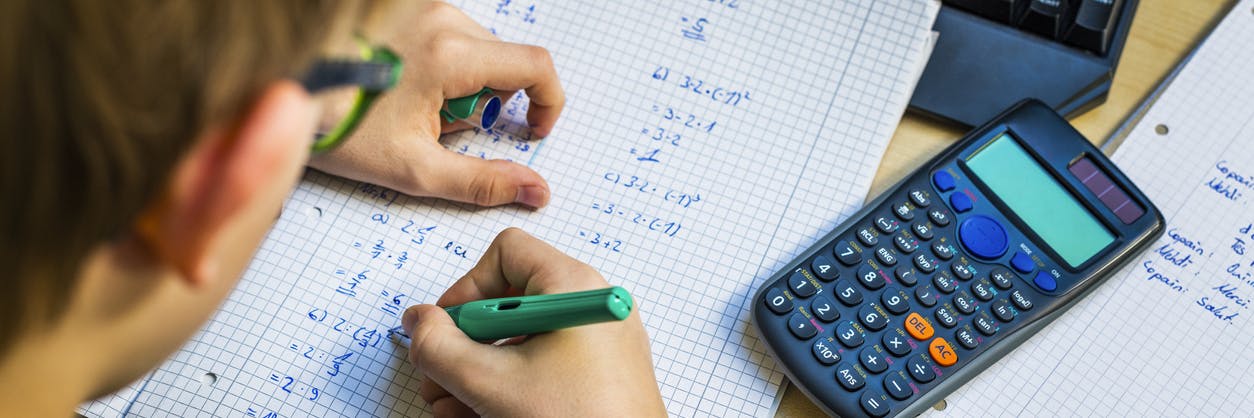
Written by Ashley Crowe
Help your child improve their math skills with the game that makes learning an adventure!
- Parent Resources
The importance of understanding basic math skills
- 9 Ways to improve math skills
- How to use technology to improve math skills
Math class can move pretty fast. There’s so much to cover in the course of a school year. And if your child doesn’t get a new math idea right away, they can quickly get left behind.
If your child is struggling with basic math problems every day, it doesn’t mean they’re destined to be bad at math. Some students need more time to develop the problem-solving skills that math requires. Others may need to revisit past concepts before moving on. Because of how math is structured, it’s best to take each year step-by-step, lesson by lesson.
This article has tips and tricks to improve your child’s math skills while minimizing frustrations and struggles. If your child is growing to hate math, read on for ways to improve their skills and confidence, and maybe even make math fun!
But first, the basics.
Math is a subject that builds on itself. It takes a solid understanding of past concepts to prepare for the next lesson.
That’s why math can become frustrating when you’re forced to move on before you’re ready. You’re either stuck trying to catch up or you end up falling further behind.
But with a strong understanding of basic math skills, your child can be set up for school success. If you’re unfamiliar with the idea of sets or whole numbers , this is a great place to start.
What are considered basic math skills?
The basic math skills required to move on to higher levels of math learning are:
- Addition — Adding to a set.
- Subtraction — Taking away from a set.
- Multiplication — Adding equal sets together in groups (2 sets of 3 is the same as 2x3, or 6).
- Division — How many equal sets can be found in a number (12 has how many sets of two in it? 6 sets of 2).
- Percentages — A specific amount in relation to 100.
- Fractions & Decimals — Fractions are equal parts of a whole set. Decimals represent a number of parts of a whole in relation to 10. These both contrast with whole numbers.
- Spatial Reasoning — How numbers and shapes fit together.
How to improve math skills
People aren’t bad at math — many just need more time and practice to gain a thorough understanding.
How can you help your child improve their math abilities? Use our top 9 tips for quickly and effectively improving math skills .

1. Wrap your head around the concepts
Repetition and practice are great, but if you don’t understand the concept , it will be difficult to move forward.
Luckily, there are many great ways to break down math concepts . The trick is finding the one that works best for your child.
Math manipulatives can be a game-changer for children who are struggling with big math ideas. Taking math off the page and putting it into their hands can bring ideas to life. Numbers become less abstract and more concrete when you’re counting toy cars or playing with blocks. Creating these “sets” of objects can bring clarity to basic math learning.
2. Try game-based learning
During math practice, repetition is important — but it can get old in a hurry. No one enjoys copying their times tables over and over and over again. If learning math has become a chore, it’s time to bring back the fun!
Game-based learning is a great way to practice new concepts and solidify past lessons. It can even make repetition fun and engaging.
Game-based learning can look like a family board game on Friday night or an educational app , like Prodigy Math .
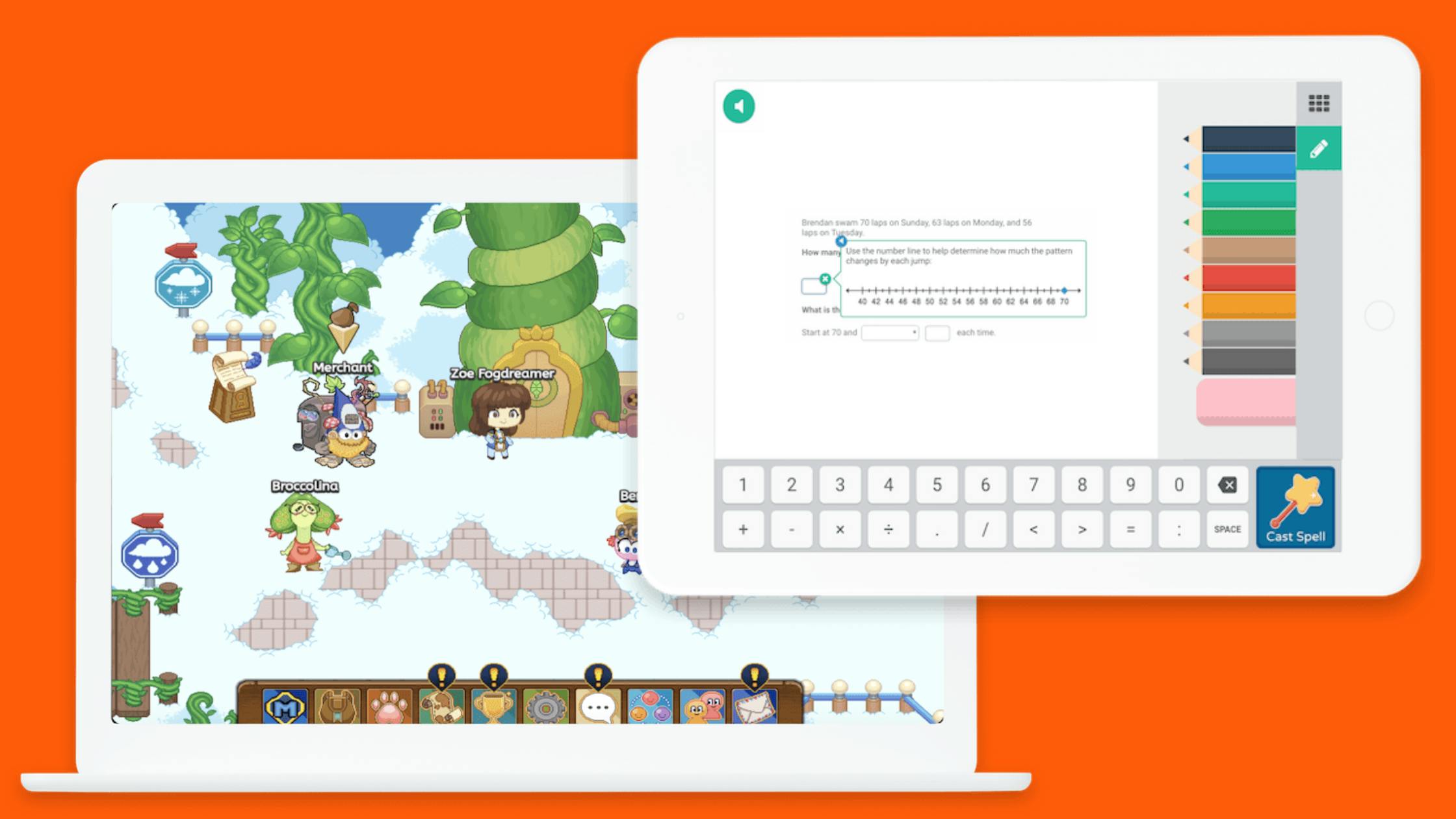
Take math from frustrating to fun with the right game, then watch the learning happen easily!
3. Bring math into daily life
You use basic math every day.
As you go about your day, help your child see the math that’s all around them:
- Tell them how fast you’re driving on the way to school
- Calculate the discount you’ll receive on your next Target trip
- Count out the number of apples you need to buy at the grocery store
- While baking, explain how 6 quarter cups is the same amount of flour as a cup and a half — then enjoy some cookies!
Relate math back to what your child loves and show them how it’s used every day. Math doesn’t have to be mysterious or abstract. Instead, use math to race monster trucks or arrange tea parties. Break it down, take away the fear, and watch their interest in math grow.
4. Implement daily practice
Math practice is important. Once you understand the concept, you have to nail down the mechanics. And often, it’s the practice that finally helps the concept click. Either way, math requires more than just reading formulas on a page.
Daily practice can be tough to implement, especially with a math-averse child. This is a great time to bring out the game-based learning mentioned above. Or find an activity that lines up with their current lesson. Are they learning about squares? Break out the math link cubes and create them. Whenever possible, step away from the worksheets and flashcards and find practice elsewhere.
5. Sketch word problems
Nothing causes a panic quite like an unexpected word problem. Something about the combination of numbers and words can cause the brain of a struggling math learner to shut down. But it doesn’t have to be that way.
Many word problems just need to be broken down, step by step . One great way to do this is to sketch it out. If Doug has five apples and four oranges, then eats two of each, how many does he have left? Draw it, talk it out, cross them off, then count.
If you’ve been talking your child through the various math challenges you encounter every day, many word problems will start to feel familiar.
6. Set realistic goals
If your child has fallen behind in math, then more study time is the answer. But forcing them to cram an extra hour of math in their day is not likely to produce better results. To see a positive change, first identify their biggest struggles . Then set realistic goals addressing these issues .
Two more hours of practicing a concept they don’t understand is only going to cause more frustration. Even if they can work through the mechanics of a problem, the next lesson will leave them feeling just as lost.
Instead, try mini practice sessions and enlist some extra help. Approach the problem in a new way, reach out to their teacher or try an online math lesson . Make sure the extra time is troubleshooting the actual problem, not just reinforcing the idea that math is hard and no fun.

Set Goals and Rewards in Prodigy Math
Did you know that parents can set learning goals for their child in Prodigy Math? And once they achieve them, they'll unlock in-game rewards of your choice!
7. Engage with a math tutor
If your child is struggling with big picture concepts, look into finding a math tutor . Everyone learns differently, and you and your child’s teacher may be missing that “aha” moment that a little extra time and the right tutor can provide.
It’s amazing when a piece of the math puzzle finally clicks for your child. If you’re ready to get that extra help, try a free 1:1 online session from Prodigy Math Tutoring. Prodigy’s tutors are real teachers who know how to connect kids to math. With the right approach, your child can become confident in math — and who knows, they may even begin to enjoy it.
8. Focus on one concept at a time
Math builds on itself. If your child is struggling through their current lesson, they can’t skip it and come back to it later. This is the time to practice and repeat — re-examining and reinforcing the current concept until it makes sense.
Look for other ways to approach new math ideas. Use math manipulatives to bring numbers off the page. Or try a learning app with exciting rewards and positive reinforcement to encourage extra practice.
Take a step back when frustrations get high — but resist the temptation to just let it go. Once the concept clicks, they’ll be excited to forge ahead.
9. Teach others math you already know
Even if your child is struggling in math, they’ve still learned so much since last year. Focus on the improvements they’ve made and let them showcase their knowledge. If they have younger siblings, your older child can demonstrate addition or show them how to use a number line. This is a great way to build their confidence and encourage them to keep going.
Or let them teach you how they solve new problems. Have your child talk you through the process while you solve a long division problem . You’re likely to find yourself a little rusty on the details. Play it up and get a little silly. They’ll love teaching you the ropes of this “new math.”
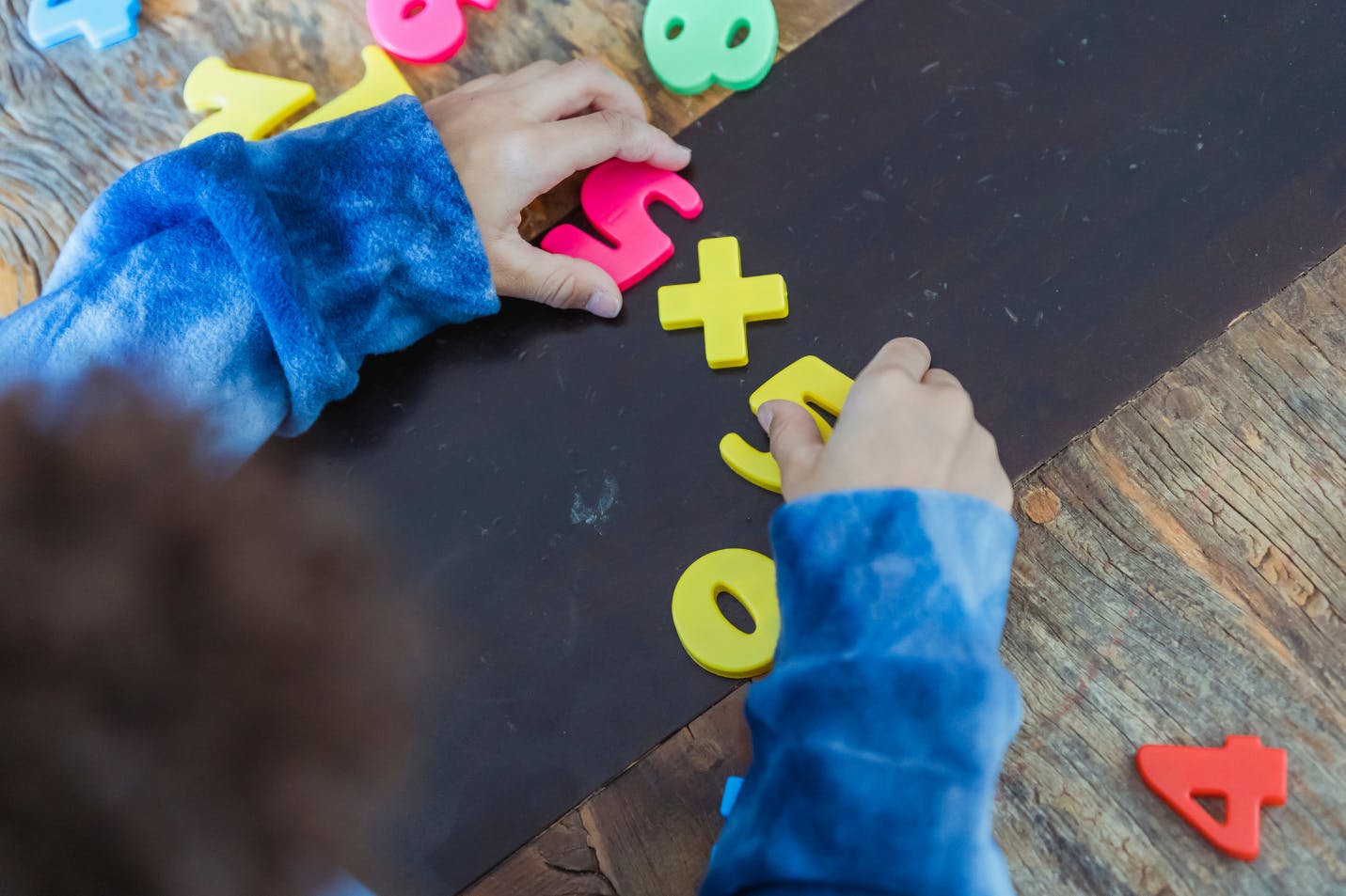
Embracing technology to improve math skills
Though much of your math learning was done with pencil to paper, there are many more ways to build number skills in today’s tech world.
Your child can take live, online math courses to work through tough concepts. Or play a variety of online games, solving math puzzles and getting consistent practice while having fun.
These technical advances can help every child learn math, no matter their preferred learning or study style. If your child is a visual learner, there’s an app for that. Do they process best while working in groups? Jump online and find one. Don’t keep repeating the same lessons from their math class over and over. Branch out, try something new and watch the learning click.
Look online for more math help
There are so many online resources, it can be hard to know where to start.
At Prodigy, we’re happy to help you get the ball rolling on your child’s math learning, from kindergarten through 8th grade. It’s free to sign up, fun to play and exciting to watch as your child’s math understanding grows.
Sign up for a free parent account and get instant data on your child’s progress as they build more math skills with Prodigy Math Game . It’s time to take the math struggle out of your home and enjoy learning together!

5 Ways to Build Math Problem Solving Skills (based on brain research)
Whether talking about state tests or meeting with your team to plan the next math unit, the conversation inevitably turns to word problems. But knowing how to build math problem-solving skills without resorting to pages of boring story problem practice can be hard.
These days word problems aren’t the basic one-step wonders that many of us dealt with as students. Instead, multi-step story problems that require students to apply multiple concepts and skills are incorporated into instruction and state assessments.
Understanding brain research can help simply the process of teaching this challenging format of math problem-solving to students, including those who struggle.

What research says about building master problem solvers in math
Have you seen how many math skills we must teach these days? No teacher has enough time to build critical math skills AND effectively teach problem-solving…or do they?
Research would argue we are going about these tasks all wrong. They say there are many reasons students struggle with math word problems , but one big one is that we aren’t doing what’s best for the brain. Instead, here’s what the brain research says about the must-have elements for building step-by-step math problem-solving mastery.
Finding #1: Becoming a master problem solver requires repetition.
Duh, right? Any good teacher knows this…but what’s the best recipe for repetition if you want students to master math word problems? How much practice? How often?
Let’s start with the concept of mastery.
How do you develop math problem solving skills?
In the 1990’s, Anders Ericsson studied experts to explore what made some people excel. Findings showed a positive correlation between the amount of deliberate practice (activities that require a high level of concentration and aren’t necessarily inherently fun) and skill level.
In other words, the more practice someone gets, the more they improve. This became the basis of Malcolm Gladwell’s 10,000-hour rule, which stated that it takes 10,000 hours to make you an expert in a field.
But what should that practice look like for students who struggle with word problems? Is it better to have a deep dive into story problems, or do short bursts of practice do more for long-term understanding?
Designing Better Word Problem Activities: Building Step-by-step Math Problem-Solving Practice
We can look at Ebbinghaus’ work on memory & retention to answer that. He found spacing practice over time decreased the number of exposures needed. In other words, small amounts of practice over several days, weeks, or even months actually means you need LESS practice than if you try to cram it all in at once.
For over 80 years, this finding has stood the test of time. While research has shown that students who engage in mass practice (lots of practice all at once) might do better on an assessment that takes place tomorrow, students who engage in repeated practice over a period of time retain more skills long-term (Bloom & Shuell, 1981; Rea & Modigliani, 1985).
And how long does the research say you should spend reviewing?

How long should problem-solving practice really be?
Shorter is better. As discussed earlier, peak attention required for deliberate practice can only be maintained for so long. And the majority of research supports 8-10 minutes as the ideal lesson length (Robertson, 2010).
This means practice needs to be focused so that during those minutes of discussion, you can dive deep – breaking down the word problem and discussing methods to solve it.
Teacher Tip: Applying this finding to your classroom
Less is actually more as long as you plan to practice regularly. While students who struggle with word problems may need a great deal of practice to master word problems, ideally, this practice should be provided in short, regular intervals with no more than 8-10 minutes spent in whole group discussion.
Here are a few simple steps to apply these findings to your math classroom:
- Find 8-12 minutes in your daily schedule to focus on problem-solving – consider this time sacred & only for problem-solving.
- Select only 1-2 word problems per day. Target step-by-step math problem-solving to build math problem-solving skills through a less-is-more approach using Problem of the Day .
Finding #2: Students who are challenged & supported have better outcomes.
Productive struggle, as it is called in the research, focuses on the effortful practice that builds long-term understanding.
Important to this process are opportunities for choice, collaboration, and the use of materials or topics of interest (which will be discussed later).
This productive struggle also helps students build flexible thinking so that they can apply previously learned skills to new or unfamiliar tasks (Bransford, Brown, & Cocking, 2000).
“Meaningful learning tasks need to challenge ever student in some way. It is crucial that no student be able to coast to success time after time; this experience can create the belief that you are smart only if you can succeed without effort.” -Carol Dweck
It is also critical to provide support and feedback during the challenging task (Cimpian, Arce, Markman, & Dweck, 2007). This prevents frustration and fear of failure when the goal seems out of reach or when a particularly challenging task arises.
Simple ways to build productive struggle into your math classroom
Giving students who struggle with word problems a chance to struggle with challenging word problems is critical to building confidence and skills. However, this challenge must be reasonable, or the learner’s self-esteem will falter, and students need support and regular feedback to achieve their potential.
Here are a few simple things to try:
- Select problems that are just at the edge of students’ Zone of Proximal Development.
- Scaffold or model with more challenging problems to support risk-taking.
- Give regular feedback & support – go over the work and discuss daily.
Finding #3: Novelty & variation are keys to engagement.
When it comes to standardized testing (and life in general), problems that arise aren’t labeled with the skills and strategies required to solve them.
This makes it important to provide mixed practice opportunities so students are focused on asking themselves questions about what the problem is asking and what they are trying to find.
This type of variation not only supports a deeper level of engagement, it also supports the metacognitive strategies needed to analyze and develop a strategy to solve (Rohrer & Taylor, 2014).
The benefits of novelty in learning
A 2013 study also supports the importance of novelty in supporting reinforcement learning (aka review). The findings suggested that when task variation was provided for an already familiar skill, it offered the following benefits:
- reduced errors due to lack of focus
- helped learners maintain attention to task
- motivated and engaged student
Using variety to build connections & deepen understanding
In addition, by providing variations in practice, we can also help learners understand the skills and strategies they are using on a deeper level.
When students who struggle with word problems are forced to apply their toolbox of strategies to novel problem formats, they begin to analyze and observe patterns in how problems are structured and the meaning they bring.
This requires much more engagement than being handed a sheet full of multiplication story problems, where students can pull the numbers and compute with little focus on understanding.
Designing word problems that incorporate variety & novelty
Don’t be afraid to shake things up!
Giving students practice opportunities with different skills or problem formats mixed in is a great way to boost engagement and develop meta-cognitive skills.
Here are a few tips for trying it out in the classroom:
- Change it up! Word problem practice doesn’t have to match the day’s math lesson.
- Give opportunities to practice the same skill or strategy in via different formats.
- Adjust the wording and/or topic in word problems to help students generalize skills.
Finding #4: Interest and emotion increase retention and skill development.
Attention and emotion are huge for learning. We’ve all seen it in our classroom.
Those magical lessons that hook learners are the ones that stick with them for years to come, but what does the research say?
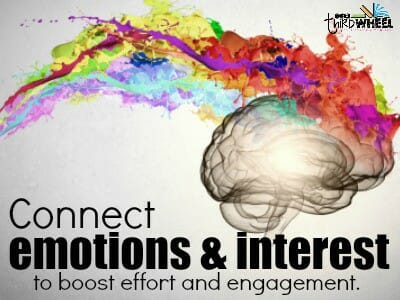
The Science Behind Emotion & Learning
Neuroscientists have shown that emotions create connections among different sections of the brain (Immordino-Yang, 2016) . This supports long-term retrieval of the skills taught and a deeper connection to the learning.
This means if you can connect problem-solving with a scenario or a feeling, your students will be more likely to internalize the skills being practiced. Whether this is by “wowing” them with a little-known fact or solving real-world problems, the emotional trigger can be huge for learning.
What about incorporating student interests?
As for student interests, a long line of research supports the benefits of using these to increase educational outcomes and student motivation, including for students who struggle with word problems (Chen, 2001; Chen & Ennis, 2004; Solomon, 1996).
Connecting classwork with student interests has increased students’ intentions to participate in future learning endeavors (Chen, 2001).
And interests don’t just mean that love of Pokemon!
It means allowing social butterflies to work collaboratively. Providing students with opportunities to manipulate real objects or create models. Allowing kids to be authentic while digging in and developing the skills they need to master their learning objectives.
What this looks like in a math class
Evoke emotion and use student interests to engage the brain in deep, long-lasting learning whenever possible.
This will help with today’s learning and promote long-term engagement, even when later practice might not be as interesting for students who struggle with word problems.
Here’s how to start applying this research today:
- Find word problems that match student interests.
- Connect real-life situations and emotions to story problem practice.
- Consider a weekly theme to connect practice throughout the week.
Finding #5: Student autonomy builds confidence & independence.
Autonomy is a student’s ability to be in control of their learning. In other words, it is their ability to take ownership over the learning process and how they demonstrate mastery.
Why students need to control their learning
Research shows that providing students a sense of control and supporting their choices is way to help engage learners and build independent thinking. It also increased intrinsic motivation (Reeve, Nix, & Hamm, 2003).
However, this doesn’t mean we just let kids learn independently. Clearly, some things require repeated guidance and modeling. Finding small ways that students can take control of the learning process is much better in these instances.
We know that giving at least partial autonomy has been linked to numerous positive student learning outcomes (Wielenga-Meijer, Taris, Widboldus, & Kompier, 2011).
But how can we foster this independence and autonomy, especially with those students who struggle to self-regulate behavior?
Fostering independence in students who struggle to stay on task
Well, the research says several conditions support building toward independence.
The first (and often neglected) is to explain unappealing choices and why they are one of the options.
When it comes to word problems, this might include explaining the rationale behind one of the strategies that appears to be a lot more work than the others.
It is also important to acknowledge students’ negative feelings about a task or their ability to complete it. While we want them to be able to build independence, we don’t want them to drown in overwhelm.
By providing emotional support, we can help determine whether a student is stuck with the learning or with the emotions from the cognitive challenge.
Finally, giving choices is recommended. Identifying choices you and your students who struggle with word problems can live with is an important step.
Whether this is working in partners, trying an alternative method, or skipping a problem and coming back, students need to feel like they have some ownership over the challenge they are working through.
By building in opportunities for autonomy, and choice, teachers help students build a sense of self-efficacy and confidence in their ability to be successful learners across various contexts (McCombs, 2002,2006).
We know this leads to numerous positive outcomes and has even been linked to drop-out prevention (Christenson & Thurlow, 2004).
Fostering autonomy in your classroom
You’re not going to be able to hold their hands forever.
Giving opportunities to work through challenges independently and to feel ownership for their choices will help build both confidence and skills.
Here’s how to get started letting go:
- Give students time to tackle the problem independently (or in partners).
- Don’t get hyper-focused on a single method to solve – give opportunities to share & learn together.
- Provide appropriate support (where needed) to build autonomy for all learners – like reading the problem orally.
Finding #6: Students need to be taught how to fail & recover from it.
Despite Ericsson’s findings discussed early on in this post, talent does matter, and it is important to teach students to recover from failure because those are the moments when they learn the most.
A 2014 study by Brooke Macnamara analyzed 88 studies to determine how talent factored into deliberate practice.
Her findings show what we (as teachers) already know, students may require different amounts of practice to reach the same skill level…but how do we keep those struggling students from keeping up?
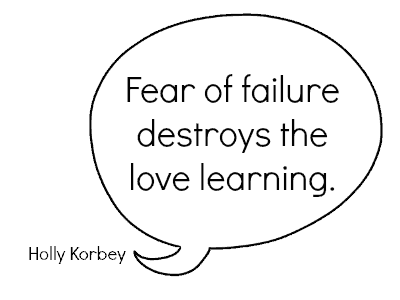
Growth mindset research gives us insight into ways to support students who struggle with word problems, encourage all students in math problem-solving, and harness the power of failure through “yet.”
You might not be able to do something yet, but if you keep trying, you will. This opens the door for multiple practice opportunities where students learn from each other.
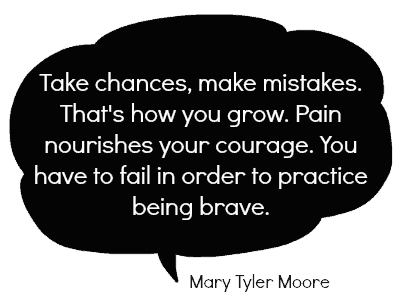
And what about the advanced students?
Many of these students have not experienced failure, but they may have met their match when it comes to complex word problems.
To support these students, who may be experiencing their first true challenge, we need to have high standards and provide constructive, supportive feedback on how to grow.
Then we need to give them space to try again.
There is great power in allowing students to revise and try again, but our grading system often discourages being comfortable with failure.
Building the confidence to fail in your classroom
Many students feel the pressure always to have the right answer. Allowing students to fail safely means you can help them learn from these failures so they don’t make the same mistake twice.
Here’s how you can safely foster growth and build math problem solving skills through failure in your classroom:
- Build in time to analyze errors & reflect.
- Reward effort & growth as much as, if not more than, accuracy.
- At least initially, skip the grading so students aren’t afraid to be wrong.
Getting started with brain-based problem solving
The brain research is clear.
Spending 45 minutes focused on a sheet of word problems following the same format isn’t the answer.
By implementing this research, you can save yourself time and the frustration from a disengaged class.
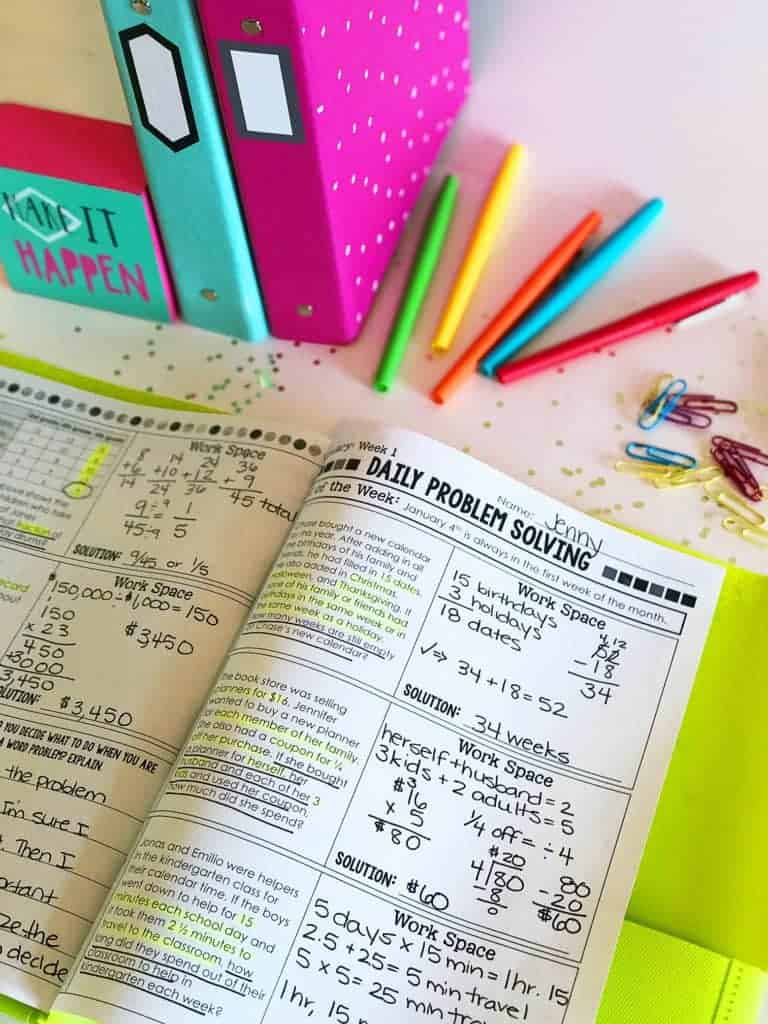
Based on this research, I’ve created Daily Problem Solving bundles to save you time and build math problem-solving skills. You can get each month separately or buy the full-year bundle at a major discount.
Currently, I offer these bundles for several grade levels, including:
Try Daily Problem Solving with your Learners
Of course, you do! Start working to build step-by-step math problem-solving skills today by clicking the button below to sign up for a free set of Daily Problem Solving.
Leave a comment Cancel reply
You must be logged in to post a comment.

Or search by topic
Number and algebra
- The Number System and Place Value
- Calculations and Numerical Methods
- Fractions, Decimals, Percentages, Ratio and Proportion
- Properties of Numbers
- Patterns, Sequences and Structure
- Algebraic expressions, equations and formulae
- Coordinates, Functions and Graphs
Geometry and measure
- Angles, Polygons, and Geometrical Proof
- 3D Geometry, Shape and Space
- Measuring and calculating with units
- Transformations and constructions
- Pythagoras and Trigonometry
- Vectors and Matrices
Probability and statistics
- Handling, Processing and Representing Data
- Probability
Working mathematically
- Thinking mathematically
- Mathematical mindsets
- Cross-curricular contexts
- Physical and digital manipulatives
For younger learners
- Early Years Foundation Stage
Advanced mathematics
- Decision Mathematics and Combinatorics
- Advanced Probability and Statistics
Published 2014 Revised 2024
Using NRICH Tasks to Develop Key Problem-solving Skills
In her article Developing Excellence in Problem Solving with Young Learners , Jennie Pennant suggests that as teachers we can help children get better at problem solving in three main ways, one of which is through 'explicitly and repeatedly providing children with opportunities to develop key problem-solving skills'. This article builds on Jennie's. In particular, it explains what we mean by 'problem-solving skills' and aims to give further guidance on how we can help learners to develop these skills by highlighting relevant NRICH tasks.
What do we mean by 'problem-solving skills'?
In the aforementioned article, Jennie outlines four stages of the problem-solving process:
By explicitly drawing children's attention to these four stages, and by spending time on them in turn, we can help children become more confident problem solvers. Jennie outlines different ways in which learners might get started on a task (stage 1), but it is once they have got going and are working on the problem (stage 2) that children will be making use of their problem-solving skills. Here are some useful problem-solving skills:
- Trial and improvement
- Working systematically (and remember there will be more that one way of doing this: not just the one that is obvious to you!)
- Pattern spotting
- Working backwards
- Reasoning logically
- Visualising
- Conjecturing
The first two in this list are perhaps particularly helpful. As learners progress towards a solution, they may take the mathematics further (stage 3) and two more problem-solving skills become important:
- Generalising
Having reached a solution, stage 4 of the process then involves children explaining their findings and reflecting on different methods used. For the purposes of this article, we will think of 'problem-solving skills' as those skills that learners need in order to work on the mathematics of a task, during stages 2 and 3 of the problem-solving process.
How can we help children get better at these problem-solving skills?

To read this content please select one of the options below:
Please note you do not have access to teaching notes, developing problem-solving skills in mathematics: a lesson study.
International Journal for Lesson and Learning Studies
ISSN : 2046-8253
Article publication date: 3 January 2017
Problem solving is a skill in mathematics which although always relevant has heightened priority due to the changes in the new mathematics GCSE (Department for Education, 2013). It has previously been a skill which is deemed underdeveloped within mathematics and therefore is a theme which teachers are seeking to improve and nurture in order to align with the new changes. The GCSE is the formal qualification that students take at the end of Key Stage 4 (KS4) in the UK. The paper aims to discuss these issues.
Design/methodology/approach
The focus of the enquiry was to explore, using lesson studies, the differences in students’ approaches to problem solving. Consequently, key themes relating to the mediation of gender, ability, and academic motivation surfaced. Considering these themes, the paper subsequently reflects upon pedagogical practices which might effectively develop students’ ability to problem solve. The study took part in a mixed gender comprehensive secondary school with students taking part in the observation lesson ranging in age from 11 to 12 years old. The authors are the teachers who took part in the lesson study. The teachers implemented observation techniques in the form of video and peer observation with the accompanying teacher. In addition, students provided feedback on how they approached the problem-solving tasks through a form of semi-structured interviews, conducted via the use of video diaries where no teachers were present to prevent power bias. Following this, a thematic analysis of both the observations and student video diaries generated conclusions regarding how said key themes shaped the students’ approaches to problem solving.
Students’ frustration and competitive need to find a specific answer inhibited their ability to thoroughly explore the problem posed thus overseeing vital aspects needed to solve the problem set. Many students expressed a passion for problem solving due to its freedom and un-rigid nature, which is something teachers should nurture.
Originality/value
Generally, teachers are led by a culture in which attainment is the key. However, an atmosphere should be developed where the answer is not the key and students can explore the vibrant diversity mathematics and problem solving can offer.
- Lesson study
- Mathematics
- Problem-solving skills
- Video diaries
Bradshaw, Z. and Hazell, A. (2017), "Developing problem-solving skills in mathematics: a lesson study", International Journal for Lesson and Learning Studies , Vol. 6 No. 1, pp. 32-44. https://doi.org/10.1108/IJLLS-09-2016-0032
Emerald Publishing Limited
Copyright © 2017, Emerald Publishing Limited
Related articles
We’re listening — tell us what you think, something didn’t work….
Report bugs here
All feedback is valuable
Please share your general feedback
Join us on our journey
Platform update page.
Visit emeraldpublishing.com/platformupdate to discover the latest news and updates
Questions & More Information
Answers to the most commonly asked questions here
3 Ways to Strengthen Math Instruction

- Share article
Students’ math scores have plummeted, national assessments show , and educators are working hard to turn math outcomes around.
But it’s a challenge, made harder by factors like math anxiety , students’ feelings of deep ambivalence about how math is taught, and learning gaps that were exacerbated by the pandemic’s disruption of schools.
This week, three educators offered solutions on how districts can turn around poor math scores in a conversation moderated by Peter DeWitt, an opinion blogger for Education Week.
Here are three takeaways from the discussion. For more, watch the recording on demand .
1. Intervention is key
Research shows that early math skills are a key predictor of later academic success.
“Children who know more do better, and math is cumulative—so if you don’t grasp some of the earlier concepts, math gets increasingly harder,” said Nancy Jordan, a professor of education at the University of Delaware.
For example, many students struggle with the concept of fractions, she said. Her research has found that by 6th grade, some students still don’t really understand what a fraction is, which makes it harder for them to master more advanced concepts, like adding or subtracting fractions with unlike denominators.
At that point, though, teachers don’t always have the time in class to re-teach those basic or fundamental concepts, she said, which is why targeted intervention is so important.

Still, Jordan’s research revealed that in some middle schools, intervention time is not a priority: “If there’s an assembly, or if there is a special event or whatever, it takes place during intervention time,” she said. “Or ... the children might sit on computers, and they’re not getting any really explicit instruction.”
2. ‘Gamify’ math class
Students today need new modes of instruction that meet them where they are, said Gerilyn Williams, a math teacher at Pinelands Regional Junior High School in Little Egg Harbor Township, N.J.
“Most of them learn through things like TikTok or YouTube videos,” she said. “They like to play games, they like to interact. So how can I bring those same attributes into my lesson?”
Part of her solution is gamifying instruction. Williams avoids worksheets. Instead, she provides opportunities for students to practice skills that incorporate elements of game design.
That includes digital tools, which provide students with the instant feedback they crave, she said.
But not all the games are digital. Williams’ students sometimes play “trashketball,” a game in which they work in teams to answer math questions. If they get the question right, they can crumble the piece of paper and throw it into a trash can from across the room.
“The kids love this,” she said.

Williams also incorporates game-based vocabulary into her instruction, drawing on terms from video games.
For example, “instead of calling them quizzes and tests, I call them boss battles,” she said. “It’s less frightening. It reduces that math anxiety, and it makes them more engaging.
“We normalize things like failure, because when they play video games, think about what they’re doing,” Williams continued. “They fail—they try again and again and again and again until they achieve success.”
3. Strengthen teacher expertise
To turn around math outcomes, districts need to invest in teacher professional development and curriculum support, said Chaunté Garrett, the CEO of ELLE Education, which partners with schools and districts to support student learning.
“You’re not going to be able to replace the value of a well-supported and well-equipped mathematics teacher,” she said. “We also want to make sure that that teacher has a math curriculum that’s grounded in the standards and conceptually based.”
Students will develop more critical thinking skills and better understand math concepts if teachers are able to relate instruction to real life, Garrett said—so that “kids have relationships that they can pull on, and math has some type of meaning and context to them outside of just numbers and procedures.”

It’s important for math curriculum to be both culturally responsive and relevant, she added. And teachers might need training on how to offer opportunities for students to analyze and solve real-world problems.
“So often, [in math problems], we want to go back to soccer and basketball and all of those things that we lived through, and it’s not that [current students] don’t enjoy those, but our students live social media—they literally live it,” Garrett said. “Those are the things that have to live out in classrooms right now, and if we’re not doing those things, we are doing a disservice.”
Sign Up for EdWeek Update
Edweek top school jobs.

Sign Up & Sign In


How is the problem-solving ability and scientific attitude of students in mathematics learning seen from the teacher’s perspective?
- Split-Screen
- Article contents
- Figures & tables
- Supplementary Data
- Peer Review
- Open the PDF for in another window
- Reprints and Permissions
- Cite Icon Cite
- Search Site
Nia Afrelia , Ali Mahmudi , Heri Retnawati; How is the problem-solving ability and scientific attitude of students in mathematics learning seen from the teacher’s perspective?. AIP Conf. Proc. 29 April 2024; 2622 (1): 080004. https://doi.org/10.1063/5.0133852
Download citation file:
- Ris (Zotero)
- Reference Manager
One of the main goals of learning mathematics is problem solving ability, which are important for every student to mastered. In addition, there is a domain of attitude that also supports problem-solving abilities, namely the scientific attitude. The important role of teachers is needed in training students’ problem-solving skills and scientific attitudes especially in learning mathematics. This study aims to describe how students’ mathematical problem-solving abilities and students’ scientific attitudes in the mathematics learning process based on teacher perceptions. This research is a qualitative with the type of phenomenology. Data were collected using online questionnaires and interviews with 10 mathematics teachers in Jambi province. Data analysis was carried out using the Milles & Huberman stage, which divided the steps of data analysis activities into several parts, there are data collection, data reduction, data display, and conclusion or verification. The results showed that the problem-solving ability and scientific attitude of students in learning mathematics based on the teacher’s perspective are not optimal, this happened not only because of factors from the students themselves but also exist big contribution by a teacher.
Citing articles via
Publish with us - request a quote.

Sign up for alerts
- Online ISSN 1551-7616
- Print ISSN 0094-243X
- For Researchers
- For Librarians
- For Advertisers
- Our Publishing Partners
- Physics Today
- Conference Proceedings
- Special Topics
pubs.aip.org
- Privacy Policy
- Terms of Use
Connect with AIP Publishing
This feature is available to subscribers only.
Sign In or Create an Account
share this!
April 29, 2024
This article has been reviewed according to Science X's editorial process and policies . Editors have highlighted the following attributes while ensuring the content's credibility:
fact-checked
trusted source
Intervention based on science of reading and math boosts comprehension and word problem-solving skills
by University of Kansas
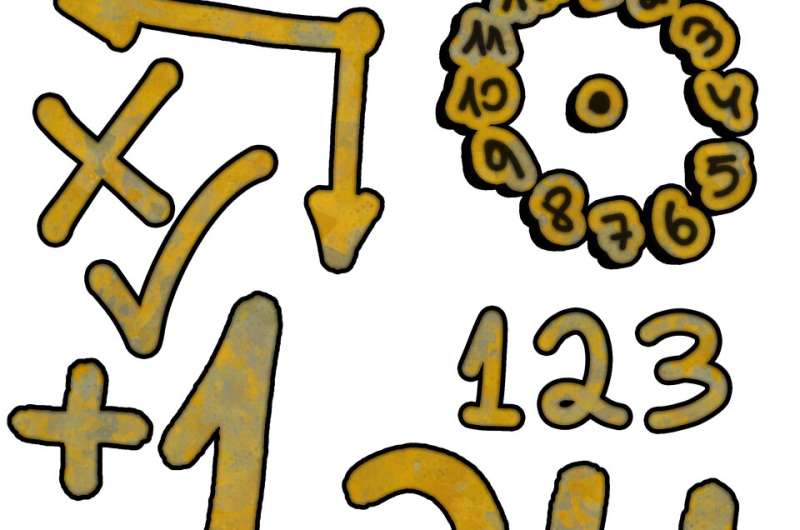
New research from the University of Kansas has found that an intervention based on the science of reading and math effectively helped English learners boost their comprehension, visualize and synthesize information, and make connections that significantly improved their math performance.
The intervention , performed for 30 minutes twice a week for 10 weeks with 66 third-grade English language learners who displayed math learning difficulties, improved students' performance when compared to students who received general instruction. This indicates that emphasizing cognitive concepts involved in the science of reading and math are key to helping students improve, according to researchers.
"Word problem-solving is influenced by both the science of reading and the science of math. Key components include number sense, decoding, language comprehension and working memory. Utilizing direct and explicit teaching methods enhances understanding and enables students to effectively connect these skills to solve math problems . This integrated approach ensures that students are equipped with necessary tools to navigate both the linguistic and numerical demands of word problems," said Michael Orosco, professor of educational psychology at KU and lead author of the study.
The intervention incorporates comprehension strategy instruction in both reading and math, focusing and decoding, phonological awareness, vocabulary development, inferential thinking, contextualized learning and numeracy.
"It is proving to be one of the most effective evidence-based practices available for this growing population," Orosco said.
The study, co-written with Deborah Reed of the University of Tennessee, was published in the journal Learning Disabilities Research and Practice .
For the research, trained tutors implemented the intervention, developed by Orosco and colleagues based on cognitive and culturally responsive research conducted over a span of 20 years. One example of an intervention session tested in the study included a script in which a tutor examined a word problem explaining that a person made a quesadilla for his friend Mario and gave him one-fourth of it, then asked students to determine how much remained.
The tutor first asked students if they remembered a class session in which they made quesadillas and what shape they were, and demonstrated concepts by drawing a circle on the board, dividing it into four equal pieces, having students repeat terms like numerator and denominator. The tutor explains that when a question asks how much is left, subtraction is required. The students also collaborated with peers to practice using important vocabulary in sentences. The approach both helps students learn and understand mathematical concepts while being culturally responsive.
"Word problems are complex because they require translating words into mathematical equations, and this involves integrating the science of reading and math through language concepts and differentiated instruction," Orosco said. "We have not extensively tested these approaches with this group of children. However, we are establishing an evidence-based framework that aids them in developing background knowledge and connecting it to their cultural contexts."
Orosco, director of KU's Center for Culturally Responsive Educational Neuroscience, emphasized the critical role of language in word problems, highlighting the importance of using culturally familiar terms. For instance, substituting "pastry" for "quesadilla" could significantly affect comprehension for students from diverse backgrounds. Failure to grasp the initial scenario could impede subsequent problem-solving efforts.
The study proved effective in improving students' problem-solving abilities, despite covariates including an individual's basic calculation skills, fluid intelligence and reading comprehension scores. That finding is key, as while ideally all students would begin on equal footing and there would be few variations in a classroom, in reality, covariates exist and are commonplace.
The study had trained tutors deliver the intervention, and its effectiveness should be further tested with working teachers, the authors wrote. Orosco said professional development to help teachers gain the skills is necessary, and it is vital for teacher preparation programs to train future teachers with such skills as well. And helping students at the elementary level is necessary to help ensure success in future higher-level math classes such as algebra.
The research builds on Orosco and colleagues' work in understanding and improving math instruction for English learners. Future work will continue to examine the role of cognitive functions such as working memory and brain science, as well as potential integration of artificial intelligence in teaching math.
"Comprehension strategy instruction helps students make connections, ask questions, visualize, synthesize and monitor their thinking about word problems," Orosco and Reed wrote. "Finally, applying comprehension strategy instruction supports ELs in integrating their reading, language and math cognition…. Focusing on relevant language in word problems and providing collaborative support significantly improved students' solution accuracy."
Provided by University of Kansas
Explore further
Feedback to editors

Research shows bumblebee nests are overheating due to climate change, threatening future populations
3 hours ago

Study finds human noise negatively impacts cricket survival and reproduction
10 hours ago

New eco-friendly lubricant additives protect turbine equipment, waterways
11 hours ago

Nanotubes, nanoparticles and antibodies detect tiny amounts of fentanyl

Bigger brains allow cliff-nesting seagull species to survive and thrive in urban environments

Oil palm plantations are driving massive downstream impact to watershed

Centipedes used in traditional Chinese medicine offer leads for kidney treatment

Physicists arrange atoms in close proximity, paving way for exploring exotic states of matter

For microscopic organisms, ocean currents act as 'expressway' to deeper depths, study finds

Targeting friends to induce social contagion can benefit the world, says new research
12 hours ago
Relevant PhysicsForums posts
Physics instructor minimum education - community college.
6 hours ago
Studying "Useful" vs. "Useless" Stuff in School
Apr 30, 2024
Why are Physicists so informal with mathematics?
Apr 29, 2024
Plagiarism & ChatGPT: Is Cheating with AI the New Normal?
Apr 28, 2024
Digital oscilloscope for high school use
Apr 25, 2024
Motivating high school Physics students with Popcorn Physics
Apr 3, 2024
More from STEM Educators and Teaching
Related Stories

Study shows program improves teaching skills, students' word problem–solving
Jun 14, 2022
Study shows approach can help English learners improve at math word problems
Jun 19, 2018

Study examines role of working memory, cognitive functions in English learners learning to write
Oct 17, 2023

Cognitive study shows lack of bilingual education adversely affects English language learners' writing skills
Oct 14, 2021

How vocabulary breadth and depth influence bilingual reading comprehension
Aug 21, 2023

Study validates the simple view of reading for enhancing second and foreign language learners' experience
Aug 17, 2023
Recommended for you

Investigation reveals varied impact of preschool programs on long-term school success
13 hours ago

Training of brain processes makes reading more efficient
Apr 18, 2024

Researchers find lower grades given to students with surnames that come later in alphabetical order
Apr 17, 2024

Earth, the sun and a bike wheel: Why your high-school textbook was wrong about the shape of Earth's orbit
Apr 8, 2024

Touchibo, a robot that fosters inclusion in education through touch
Apr 5, 2024

More than money, family and community bonds prep teens for college success: Study
Let us know if there is a problem with our content.
Use this form if you have come across a typo, inaccuracy or would like to send an edit request for the content on this page. For general inquiries, please use our contact form . For general feedback, use the public comments section below (please adhere to guidelines ).
Please select the most appropriate category to facilitate processing of your request
Thank you for taking time to provide your feedback to the editors.
Your feedback is important to us. However, we do not guarantee individual replies due to the high volume of messages.
E-mail the story
Your email address is used only to let the recipient know who sent the email. Neither your address nor the recipient's address will be used for any other purpose. The information you enter will appear in your e-mail message and is not retained by Phys.org in any form.
Newsletter sign up
Get weekly and/or daily updates delivered to your inbox. You can unsubscribe at any time and we'll never share your details to third parties.
More information Privacy policy
Donate and enjoy an ad-free experience
We keep our content available to everyone. Consider supporting Science X's mission by getting a premium account.
E-mail newsletter

IMAGES
VIDEO
COMMENTS
Decision Making: Choose the most suitable method to address the problem. Implementation: Put the chosen solution into action. Evaluation: Reflect on the solution's effectiveness and learn from the outcome. By embedding these steps into mathematical education, we provide students with a structured framework. When they wonder about how to ...
Here are five strategies to help students check their solutions. 1. Use the Inverse Operation. For simpler problems, a quick and easy problem solving strategy is to use the inverse operation. For example, if the operation to solve a word problem is 56 ÷ 8 = 7 students can check the answer is correct by multiplying 8 × 7.
There will be lots of answers, but no 'right' answer. Communicate. To solve the word problem we need to find the numbers that will go into 20 without a remainder (the factors). The factors of 20 are 1, 2, 4, 5, 10 and 20. Combinations of numbers that could work are: 1, 1, 20 1, 2, 10 1, 4, 5 2, 2, 5. Reflect.
More than just earning good grades in math, mathematical literacy is a vital life skill that can open doors to economic opportunities, improve financial management, and foster critical thinking. We're not the only ones who say so: Math learning enhances problem-solving skills, critical thinking, and logical reasoning abilities. (Source ...
The most remarkable technique for problem solving in mathematics is to help students see patterns in math problems by instructing them how to extract and list relevant details. This method may be used by students when learning shapes and other topics that need repetition. Students may use this strategy to spot patterns and fill in the blanks.
Here are some strategies to help you effectively understand and solve math word problems: 1. Highlight key information: As you read the word problem, underline or highlight any important details, such as numbers, units of measurement, or specific keywords related to mathematical operations. 2.
Telling a student to reread the problem or to think about what tools or resources would help them solve it is a way to get them to try something new but not take over their thinking. These skills are also transferable across content, and students will be reminded, "Good readers and mathematicians reread.". 6.
Not all games are created equal, however. While first-person shooter games can improve your spatial reasoning, they are not as effective as others at developing problem solving skills. [13] Play something that will force you to think strategically or analytically. Try a puzzle game like Tetris.
The skills the problem solvers developed in math transferred, and these students flourished. We use math to teach problem solving because it is the most fundamental logical discipline. Not only is it the foundation upon which sciences are built, it is the clearest way to learn and understand how to develop a rigorous logical argument.
Math Teacher. Develop your mental math skills. Mental math is when you perform mathematical calculations without using calculators, paper, or counting aids. Use your mind, memory, lessons, and discussions with your classmates to refine your math skills and build strong problem-solving strategies. 4.
This article has tips and tricks to improve your child's math skills while minimizing frustrations and struggles. If your child is growing to hate math, read on for ways to improve their skills and confidence, and maybe even make math fun! ... Approach the problem in a new way, reach out to their teacher or try an online math lesson. Make ...
A Guide to Problem Solving. When confronted with a problem, in which the solution is not clear, you need to be a skilled problem-solver to know how to proceed. When you look at STEP problems for the first time, it may seem like this problem-solving skill is out of your reach, but like any skill, you can improve your problem-solving with practice.
This article forms part of our Problem-solving Classroom Feature, exploring how to create a space in which mathematical problem solving can flourish. At NRICH, we believe that there are four main aspects to consider: • Highlighting key problem-solving skills. • Examining the teacher's role. • Encouraging a productive disposition.
Here's how you can safely foster growth and build math problem solving skills through failure in your classroom: Build in time to analyze errors & reflect. Reward effort & growth as much as, if not more than, accuracy. At least initially, skip the grading so students aren't afraid to be wrong.
improve mathematical problem-solving skills. EURASIA J Math Sci and Tech Ed 3 / 10 . ... mathematical problem-solving skills, and effect/role of assessments on students' mathematical problem-solving skills' as keywords, 63 studies were obtained. With a deep analysis of the collected data, 32 studies were related to teaching strategies in ...
Problem-solving involves utilizing critical thinking based on knowledge and information from your collective experiences to identify, analyze, and solve complex problems. Mathematics provides a systematic and logical framework for problem-solving and critical thinking. The study of math helps to develop analytical skills, logical reasoning, and ...
Pattern spotting. Working backwards. Reasoning logically. Visualising. Conjecturing. The first two in this list are perhaps particularly helpful. As learners progress towards a solution, they may take the mathematics further (stage 3) and two more problem-solving skills become important: Generalising. Proving.
mathematical problem-solving by providing visual tools called Problem-solving Keys, would improve students' performance in tasks and skills in justifying their reasoning. To map students' problem -solving skills and strategies, data from 25 fifth graders' pre-tests and post-tests with non-routine mathematical tasks were analysed.
Learning problem-solving techniques is a must for working professionals in any field. No matter your title or job description, the ability to find the root cause of a difficult problem and formulate viable solutions is a skill that employers value. Learning the soft skills and critical thinking techniques that good problem solvers use can help ...
Option 1: improve your mathematical thinking by yourself. This means trying to approach the problem from all the possible points of view that you can imagine. ... Somehow I struggled through it though, and graduated, but I always felt uneasy about having as solid of problem-solving skills in my educational foundation as I wanted on it ...
This study can provide an alternative or guidance for teachers to improve students' mathematical problem-solving skills. Keywords: problem-solving strategies, visualisation techniques, bar model, mathematical problem-solving skills . INTRODUCTION Problem-solving is an important skill that one must have. Problem-solving in mathematics helps ...
and Kilpatrick, 1989) and genuine mathematical problem-solving is one of the most important components in any mathematics program or curriculum (Stacey, 2005; Halmos, 1980; Cockcroft, 1982). Mathematical problem-solving may help students to improve and develop the standard ability to solve real-life problems, (Reys et al. 2001), to develop critical
Purpose. Problem solving is a skill in mathematics which although always relevant has heightened priority due to the changes in the new mathematics GCSE (Department for Education, 2013). It has previously been a skill which is deemed underdeveloped within mathematics and therefore is a theme which teachers are seeking to improve and nurture in ...
Here are three takeaways from the discussion. For more, watch the recording on demand. 1. Intervention is key. Research shows that early math skills are a key predictor of later academic success.
The best approach for learning pure math is to start with a strong foundation in basic concepts and principles. This includes understanding number systems, algebraic operations, and geometry. From there, it is important to practice regularly and consistently, as math is a subject that requires practice to truly understand and master. 2.
Intervention based on science of reading, math boosts comprehension, word problem-solving skills. ScienceDaily . Retrieved April 29, 2024 from www.sciencedaily.com / releases / 2024 / 04 ...
The important role of teachers is needed in training students' problem-solving skills and scientific attitudes especially in learning mathematics. This study aims to describe how students' mathematical problem-solving abilities and students' scientific attitudes in the mathematics learning process based on teacher perceptions.
Study shows program improves teaching skills, students' word problem-solving Jun 14, 2022 Study shows approach can help English learners improve at math word problems